Overview
The 2020 Euro money market study is a comprehensive analysis of the functioning of euro money markets. The study covers five segments of the euro money markets: (i) secured transactions – repos and reverse repos; (ii) unsecured transactions; (iii) the issuance of short-term securities (STS); (iv) foreign exchange (FX) swaps and (v) overnight index swaps (OIS). The study describes developments in these segments between January 2019 and December 2020.
The study relies predominantly on granular data collected through the Eurosystem’s money market statistical reporting (MMSR) dataset. MMSR data have been collected since 1 July 2016 and contain details on volume, pricing, maturity and counterparty for each transaction of less than one year executed by the 48 largest euro area banks. Actual daily transactions are reported to the European Central Bank (ECB) on the subsequent business day, providing a timely insight into market developments. MMSR data cover four out of the five segments of the euro money markets. Information on the fifth segment – STS issuance – is provided by the statistics on Short-Term European Paper (STEP) and French Negotiable European Commercial Paper (NEU CP) collected by the ECB and the Banque de France respectively and complemented with commercial paper data from Dealogic.
Several events of relevance for euro money markets occurred between January 2019 and December 2020. These events included: (i) an interest rate cut of 10 basis points on the Eurosystem’s deposit facility rate (DFR), implemented on 12 September 2019; (ii) the introduction of the new unsecured euro short-term rate (€STR) developed by the ECB and published as of 2 October 2019; (iii) the implementation of the two-tier system on 30 October 2019 to exempt a part of banks’ holdings of excess reserves from being remunerated at negative rates; (iv) the outbreak of the worldwide COVID‑19 pandemic in spring 2020, followed by the ECB monetary policy measures resulting in a €2.3 trillion expansion of the Eurosystem’s balance sheet; finally, (v) the materialisation of Brexit at the end of 2020.
The main developments in euro money markets can be summarised as follows.
First, the secured and FX swap segments continued to dominate activity in the euro money markets. During the review period, total average daily transaction volumes (flows) for these two segments amounted to €0.9 trillion, with outstanding amounts (stock) reaching €6.0 trillion[1]. The secured segment is the largest segment of the euro money markets, accounting for 60% of total daily transaction volumes and 51% of total outstanding amounts. Traditionally, the unsecured segment has played a key role in monetary policy transmission, although the current secured segment, given its sheer size, has gained in importance for the assessment of financing conditions and thus for monetary policy implementation over the years. The second-largest segment is the FX swap segment, which represents 22% of the total flows and 43% of the total stock of the euro money markets. Following the outbreak of the COVID‑19 pandemic in March 2020, the Eurosystem reacted decisively by providing banks a backstop in case market funding became unavailable or very costly. By the end of 2020, euro area banks had drawn a total of €1.8 trillion from the ECB’s targeted longer-term refinancing operations (TLTROs) and temporarily covered their US dollar funding needs of USD 143.5 billion by recourse to a swap line network established by major central banks at the peak of the crisis.
Figure A
Overview of the size of the euro money market
(EUR billions)

Sources: ECB (MMSR), ECB calculations and Centralised Securities Database (CSDB) for STS series.
Notes: Panel (a) – average daily transaction volumes include all reported counterparties. The OIS segment excludes novations.
Panel (b) – outstanding amounts transform the daily transaction volumes (flows) into a stock variable based on maturity dates reported on the last day of each month. STS data refer to commercial paper and certificates of deposit with a maturity of up to 12 months and concerning only euro area issuers that are deposit-taking corporations (only in EUR).
Second, the spread between repo rates of different jurisdictions narrowed significantly, facilitating the smooth transmission of monetary policy, while the spread between the repo rates and the DFR was sensitive to the availability of government bonds in the market. In 2018, repo rates diverged significantly across the euro area, with rates for core countries collateral trading well below the DFR and rates for semi-core collateral trading below but much closer to the DFR. Over the review period repo rates converged in a sustained manner. In this regard, several factors played a role. In 2019, Eurosystem asset purchases temporarily plateaued, reducing the absorption of collateral from the market; this resulted in an increase to close to the DFR in the secured rates of different jurisdictions. In the first half of 2020, the reactivation of Eurosystem net asset purchases and the start of the PEPP coincided with strong issuance activity by governments, keeping rates stable and just below the DFR. Governments’ issuance activity slowed in the second half of 2020 and repo rates embarked on a downward trend, reflecting the renewed collateral scarcity effect in a context of increasing excess liquidity. These developments highlight the sensitivity of prices in the secured segment to the availability of government bonds in the markets, as 90% of secured volumes are backed by specific collateral. To alleviate the scarcity of government bonds, the Eurosystem implemented two measures. First, it eased the collateral framework for central bank lending operations, accepting a wider use of credit claims and temporarily increasing risk tolerance. This allowed banks to pledge non-marketable securities for the purpose of Eurosystem refinancing operations such as TLTROs. Second, the Eurosystem made its asset holdings available for lending through the securities lending facility. Both APP and PEPP holdings of public sector securities can be borrowed against cash or other collateral, thus increasing the availability of high-quality liquid assets in the market.
Third, the COVID‑19 pandemic revealed the contrast between the resilience of the secured segment and the distortions observed in the FX swap, STS and unsecured term segments. Owing to the high reliance on central clearing (70%), the secured segment remained robust despite the increased risk aversion throughout spring 2020. The remaining 30% of secured transactions were traded bilaterally and have also proved to be relatively resilient throughout the pandemic. Banks accounted for the largest volume of bilateral secured transactions, followed by non-banks (investment funds, MMFs and insurance companies), whose share increased notably in 2020. In contrast to the developments in the secured segment, other money market segments experienced short-lived turbulence at the peak of the pandemic. In spring 2020, there was a sharp rise in unsecured term rates, while rates for commercial paper rose quickly as demand for STS from MMFs stagnated at the peak of the pandemic. The cost of borrowing US dollars against euro in the FX swap markets also peaked at above 500 basis points at the height of uncertainty in late March 2020. Developments in the STS and FX swap markets also had spill-over effects on the unsecured EURIBOR. Eurosystem and Federal Reserve System interventions alleviated tensions in the three money market segments suffering the biggest disruptions, which returned to normal functioning in the second half of 2020. The US dollar liquidity provision by the swap line network of major central banks was particularly useful in solving distortions in the FX swap segment and the inclusion of NFC CPs in the purchases under the PEPP partially addressed tensions in the STS market, which resulted in EURIBOR falling to its lowest level ever. The liquidity providing operations of the Eurosystem (bridge LTROs, TLTROs and PELTROs) have also ensured favourable financing conditions and contributed to lowering unsecured term rates.
Figure B
Overview of the rates in the euro money market
(left-hand side: percentages; right-hand side: EUR billions)
a) Government repo rates by jurisdiction
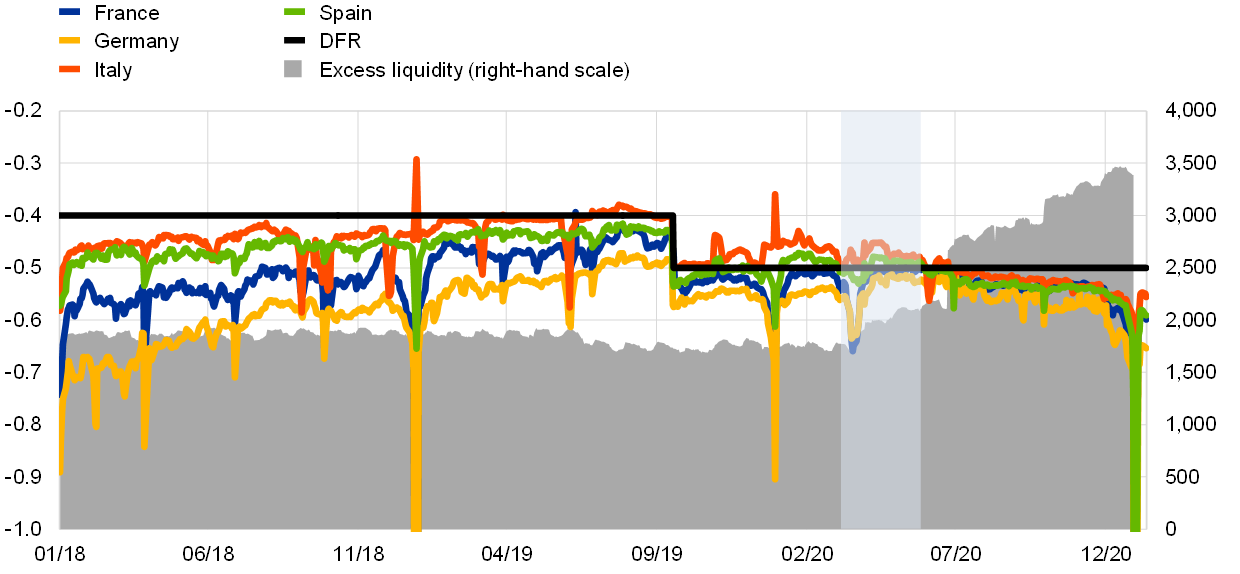
b) STS rates and EURIBOR

c) FX swap basis spread (EUR/USD)
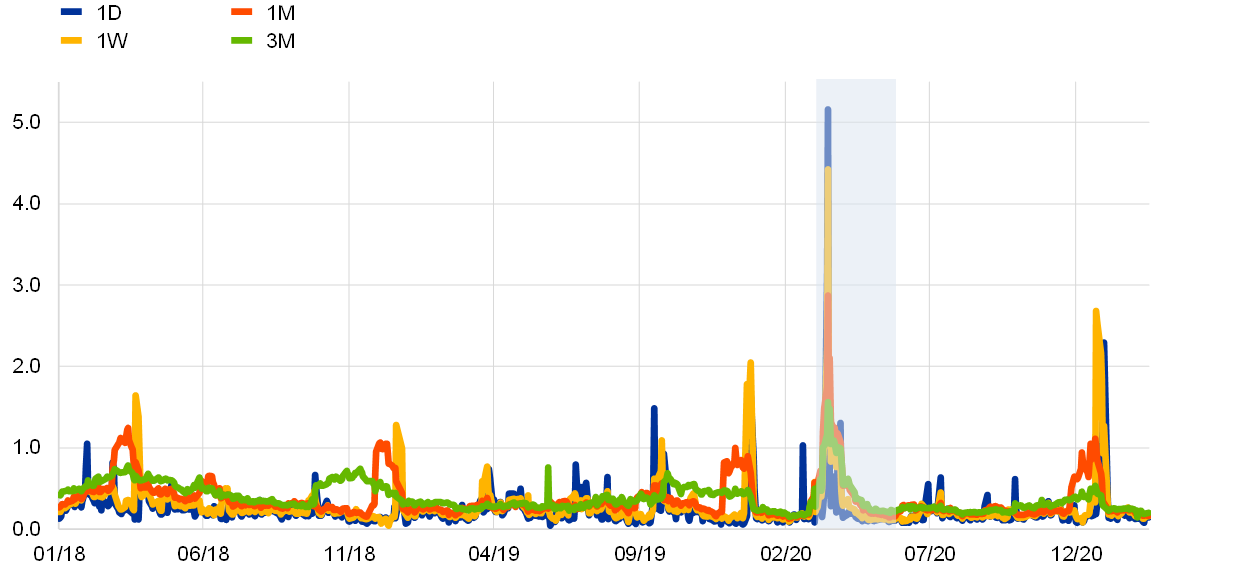
Sources: Panel (a) – ECB (MMSR); Panel (b) – STS (Banque de France); Panel (c) – ECB (MMSR), Bloomberg and ECB calculations.
Notes: Panel (a) – Volume-weighted average rate per collateral jurisdiction – only government collateral included. Plotted against settlement date. The scale is limited to ‑1%, for readability. Cut-off points: year-end 2019 DE ‑2.74% and FR ‑2.13%; year-end 2020 DE: ‑2.09%, FR: ‑1.57% and ES: ‑1.59%. Only trades with O/N, S/N and T/N maturities. The rate includes both borrowing and lending transactions. Panel (b) – “STS” stands for short term debt issuance based on NEU CP data. Panel (c) – The FX swap basis spread is calculated as the USD implied rate minus the USD OIS rate for the selected maturity. The axis is cut off at 300 basis points in the interests of readability. One-day trades combine the O/N, S/N and T/N for a selected settlement day. Confidential and missing values hidden. Blue area highlights the COVID‑19 crisis period.
1 The secured segment
The secured segment became the largest segment of the euro money market around the time of the GFC and has continued to grow ever since. During 2019 and 2020, market players continued to prefer secured trading because of its lower regulatory costs and counterparty risks compared with unsecured trading. Interbank trading of reserves now takes place mostly in the secured market.
Secured rates reflect developments in the supply of and demand for cash and collateral. During the review period, the supply of cash-reserves increased due to ECB monetary policy easing, which was reflected in the ample provision of additional liquidity. At the same time, the supply of collateral was drained due to large-scale Eurosystem additional asset purchases, while demand remained sufficiently firm to meet regulatory requirements. Both factors contributed to downward pressures on repo rates within the period under review.
In addition, there were four other notable developments in the secured segment over the period 2019‑20.
First, the euro area repo rate converged towards the DFR in 2019, after the former series of the Eurosystem’s net asset purchases had ended. However, the COVID‑19 pandemic and the Eurosystem’s policy response which included a new series of net asset purchases caused repo rates to fall below the DFR once again in 2020.
Second, the secured nature of repo transactions – the majority of which are centrally cleared – has made the euro money market more resilient to financial stress. CCPs mitigate counterparty risk and reduce reliance on costly collateral by providing netting services. During the pandemic an increase in bilateral repo trading with non-banks – mainly MMFs and insurance companies – has also been observed. Lack of confidence in secondary market liquidity of the commercial paper segment encouraged these counterparties to opt for the secured segment to increase their liquidity buffers, independently of their customer status with CCPs. They were attracted by large trading volume and stable yield curve of the secured segment during spring 2020. This confirms the trust placed in the stable nature of the repo market, which has functioned well during the COVID‑19 crisis.
Third, there was a sizeable shift in activity from UK to euro area counterparties, coinciding with the UK’s withdrawal from the EU. The euro repo market is now mainly concentrated in the hands of players located in the euro area, which account for 90% of total trading.
Finally, the introduction on 31 October 2019 of the two-tier system for remunerating banks’ reserves incentivised reserves redistribution between banks through the repo market. The introduction of the two-tier system led to a short-lived increase in repo rates in non-core jurisdictions, although this effect did not last.
1.1 Volumes
2019‑20 trends
The secured segment is by far the largest segment of the euro money market, representing slightly more than two-thirds of total market turnover (see Chart 1.1). It significantly increased in size around the time of the GFC and has continued to grow ever since[2]. Counterparties favour secured trading in order to reduce regulatory costs and counterparty risk. Unsecured lending incurs higher capital charges owing to counterparty credit risk, and this is further exacerbated when the lending is to a non-euro area entity. Moreover, unsecured borrowing requires deposits to be backed by high-quality liquid assets. The liquidity risk is particularly relevant for banks borrowing for tenors below one month or accepting non-operational deposits, as these are considered less stable and hence incur higher liquidity costs under the liquidity coverage ratio (LCR).
The daily average volume of secured transactions amounted to €645 billion in the period 2019‑20. Most of these transactions – around €520 billion of daily average turnover – were conducted between euro area banks or through CCPs. In 2020, the outstanding amount of repo operations amounted to €3.3 trillion.
Chart 1.1
Market size per segment – average daily transaction volumes
(EUR billions)

Sources: Panel (a) – ECB (euro money market survey) until 2016 and ECB (MMSR) from 2016 onwards; Panel (b) – ECB (MMSR).
Notes: Panel (a) includes only interbank counterparties and CCPs; Panel (b) – includes all reported counterparties. The bars show euro money market survey data for 38 overlapping reporting agents and retropolated data for the 14 MMSR reporting agents not covered in the survey. The retropolation increases the original series by a fixed proportion representing the 14 missing reporting agents’ market share in Q3 2016 (3% for the secured segment). Two confidential datapoints have been interpolated. The OIS segment excludes novations in MMSR data.
Outstanding secured volumes grew during 2019‑20 – in contrast to the other segments of the money market – even during the pandemic (see Chart 1.2). Volumes peaked in early March 2020 as participants increased their secured trading, given the uncertain environment. This rise was mostly observed for banks, MMFs and insurance companies and was concentrated in bilateral trading (i.e. not trading via a CCP). These counterparties increased their liquidity buffers during the crisis. Lack of confidence in secondary market liquidity of the commercial paper segment encouraged these counterparties to opt for the secured segment to increase their liquidity buffers, independently of their customer status with CCPs. They were attracted by large trading volume and stable yield curve of the segment during spring 2020. The repo segment has functioned well during the COVID‑19 pandemic, reflecting the safe and liquid characteristics of the secured segment. This is partly due to the large share of trades cleared through CCPs, which mitigate counterparty risk and provide netting benefits to their users. Thanks to their lower risk profile, secured transactions were much less affected by market stress in the spring of 2020 than unsecured trades. A stable bilateral yield curve was also preserved, although to a lower extent than for trading through CCP.
Chart 1.2
Outstanding amounts borrowed and lent by euro area banks
(EUR billions)
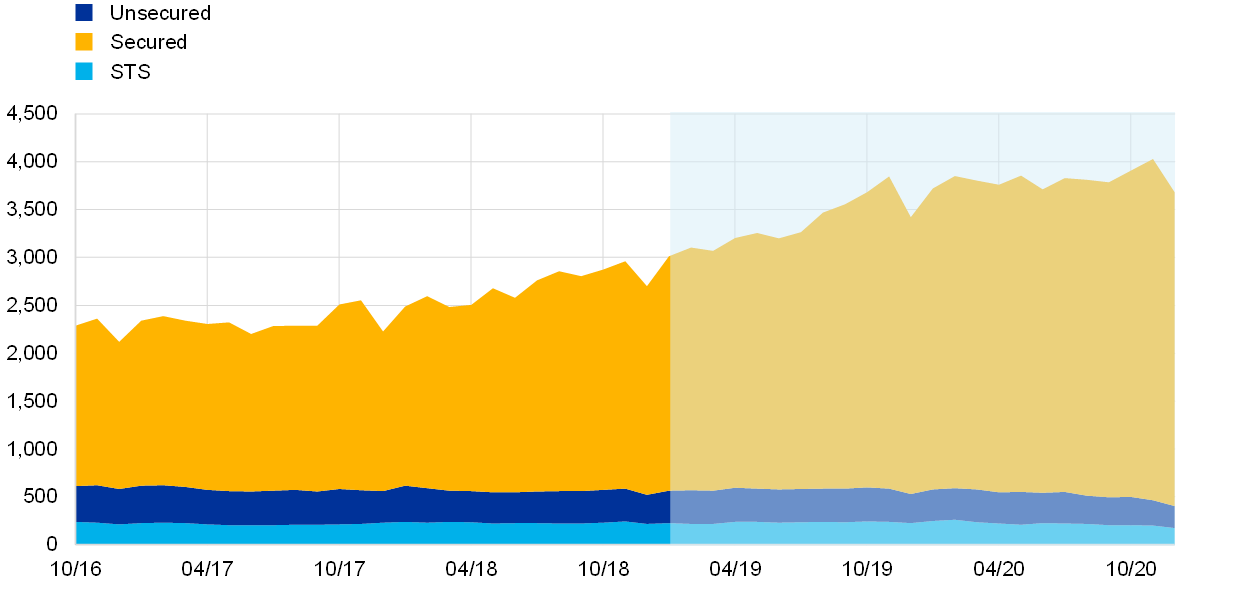
Sources: ECB (MMSR for “Unsecured” and “Secured” data), CSDB for STS data.
Notes: “Secured” and “Unsecured” data represent the outstanding amounts borrowed and lent by MMSR banks, with “Unsecured” excluding any short-term debt instruments. “STS” data refer to the outstanding amounts issued or held by euro area banks (only in EUR currency). Tenors are up to one year. The stacked areas show the amounts outstanding on the last day of each month.
Borrowing activity remained slightly above lending activity, representing around 55% of secured turnover[3] (see Chart 1.3). Market intelligence suggests that for most banks their business models determine whether they are structural cash borrowers or lenders. Some more specialised banks act as market-makers and manage “matched” repo books – i.e. broadly matching their repo borrowing and lending. However, these banks may also skew their activities slightly towards borrowing or lending, depending on their needs.
Chart 1.3
Trends in daily transaction volumes
(EUR billions)

Source: ECB (MMSR).
Note: The period under review is indicated by a light blue background.
The relationship between reporting dates and volumes
Turnover in the secured segment tends to drop at quarter-end and year-end, for the purposes of “window dressing” (see Chart 1.2 above). Close to regulatory reporting dates banks reduce the size of their balance sheets in order to comply with prudential regulations and to optimise bank levies. During these periods a general reduction of borrowing activity is therefore observed when banks’ leverage ratio is close to the regulatory minimum and/or they prefer to engage in collateral swap trades (e.g. bond vs. bond removing the two cash legs) to increase netting.
Significant prefunding activity is noticeable around year-end dates since 2018 (see Chart 1.4). Prefunding consists of conducting trades that span the year-end reporting date but are agreed well ahead of the settlement date. Spreading out the impact of year-end trading over a longer period allows clients and dealers to minimise the tensions which arise when last-minute demands can only be accepted by dealers at punitive rates. Since 2017 the volume of prefunding has increased significantly and has been cited by market participants as one of the reasons behind the less stressed year-ends seen in recent years.
Chart 1.4
Year-end prefunding in the repo market
(EUR billions)

Source: ECB (MMSR) and ECB calculations.
Notes: Includes secured trade volumes that settle up to three months before year-end and mature up to three months after year-end. Only collateral by Belgian, German, Spanish, French, Italian and Dutch counterparties is taken into account. Only TARGET2 business days are used. Cumulative volumes.
1.2 Collateral
General collateral and specific collateral size
There are two collateral management subsegments for secured trading: general collateral (GC) and specific collateral (SC). GC trades are undertaken during a search for cash funding against a pre-defined pool of substitutable collateral (collateral baskets) – sometimes they are classified as tri-party GC trades as collateral management is often outsourced to a third party. In SC trades the counterparties manage the collateral themselves. SC trades can be divided into two categories depending on their rate: (i) trades which take place at rates at or close to the GC rate; and (ii) trades for a specific bond which take place at rates noticeably below the GC rate, and which are often called “special” repo transactions to emphasise the importance of the security on the transaction value.
GC trades represent only 10% of total secured transactions while the remaining 90% are specific collateral (see Chart 1.5). The small share of GC trades increased in the second half of 2019, coinciding with the introduction of the two-tier system. This increase was particularly concentrated in GC trades using Italian collateral. Overall, specific trading has remained dominant in recent years, reflecting firms’ desire to exercise greater control over collateral management practices.
Chart 1.5
Secured volumes by collateral type
(EUR billions)

Sources: BrokerTec and MTS.
Notes: O/N, S/N and T/N maturities only. Euro area countries: BE, DE, IE, GR, ES, FR, IT, NL, AT, PT, SI, FI.
2019‑20 trends
Government bonds are the dominant type of collateral in the euro-denominated repo market, accounting for 85% of all transactions. This share remained stable during the review period and is in line with previous money market study results. The reliance on sovereign collateral can be explained by the zero-risk weight on sovereign bond holdings and high levels of liquidity of government bonds compared with other securities. The bonds are also easy to source for participants given the large size of the euro government bond market.
The most-used government bonds are issued in the biggest euro area economies. Given the size, breadth and depth of the respective sovereign debt markets, bonds issued by governments in Germany, France, Italy, Spain, the Netherlands and Belgium account for 92% of the total public collateral used in secured transactions. The share of these six sovereign issuers used to secure repo transactions has been very stable over the last couple of years.
A smaller share of transactions (15%) used private sector collateral. Bonds issued by financial companies accounted for most of the private sector collateral. At the beginning of 2020, the use of private sector collateral increased, reaching a peak of around 19% in May 2020 at the expense of general government collateral. This was attributed to the elevated levels of private debt issuance during that period, as market conditions improved. The actions of the Eurosystem, which included an increase in private bond purchases and measures to temporarily ease collateral framework, also contributed to the improvement of market conditions and supported this dynamic.
Maturity analysis shows that non-government collateral is more prevalent in repo transactions at longer maturities. Debt issued by financial corporations is used in 40% of trades which are longer than one month even though they only represent 12% of total repo transactions.
Euro area banks used predominantly non-domestic collateral in their secured transactions, except for those in Italy and, to a lesser extent, Spain (see Chart 1.6). The share of non-domestic collateral (collateral issued in a country other than that in which the bank is domiciled) is around 63% of the total weighted volume. Nevertheless, the share of domestic collateral usage differs between participants. Italian and Spanish banks report a higher use of domestic collateral, while German and French banks report a higher share of non-domestic collateral.
Chart 1.6
Origin of government collateral used, by location of reporting agent
(percentages)

Source: ECB (MMSR).
Note: Only transactions secured by government collateral.
The relationship between excess liquidity and GC/SC volume
GC and SC repo transactions display different correlations with excess liquidity, given their differing scope (see Chart 1.7). Prior to the pandemic, an increase in excess liquidity was associated with a notable increase in SC repo volumes and a decline in repos backed by GC. This difference is because the Eurosystem intervention alters the supply of both cash and collateral. GC transactions – exclusively used for cash management purposes – decline, on average, as the Eurosystem’s liquidity injection reduces the banking sector’s funding needs. However, SC transactions – often used for collateral management purposes – tend to increase. This can be explained by the reduction in collateral available in the market due to the sizeable amount of securities drained by the Eurosystem via both asset purchases and collateralised lending operations. During the COVID‑19 crisis, the positive correlation between SC repo volumes and the growth of excess liquidity has ceased to apply. This appears to indicate that the Eurosystem’s securities lending programme has managed to alleviate the collateral shortage, reducing market needs for SC. Moreover, national governments increased their bond issuances, making more securities available for trades also in the secondary market. On the other hand, the negative correlation between the growth of excess liquidity and GC repo volumes is still observed and has even strengthened.
Chart 1.7
Correlation between secured transaction volumes and excess liquidity
(y-axis: EUR billions; x-axis: EUR trillions)

Sources: BrokerTec/MTS and Bloomberg (liquidity statistics).
Notes: The blue dots represent the period before the COVID‑19 pandemic when excess liquidity was increasing (July 2016 – December 2018). The yellow dots represent the expansion of excess liquidity following the outbreak of the COVID‑19 pandemic (March – December 2020). The horizontal axis refers to daily euro excess liquidity. The vertical axis refers to daily total secured O/N, S/N and T/N volumes of euro area countries. Only government collateral.
1.3 Rates
2019‑20 trends
The euro repo rate traded below but closer to the DFR until mid‑2020, when secured rates began to fall back below the DFR as a result of the Eurosystem’s monetary policy actions (see Chart 1.R.1). Repo rates reflect developments in the supply of and demand for both cash and collateral. In 2019, net asset purchases by the Eurosystem under the asset purchase programme (APP) ceased, and only reinvestments were made. However, during this phase the Eurosystem continued its securities lending activities. These two factors increased the availability of government bonds in the market, so repo rates rose towards the DFR. As regards the cash, despite the stable excess liquidity, the introduction of the two-tier system in October 2019 provided an incentive to redistribute liquidity among euro area bank. Most of the cross-border redistribution within euro area took place through the secured segment. As a result of these transactions, repo rates against non-core collateral temporary increased, reflecting the higher rates paid by some Italian banks to borrow liquidity to fulfil their exempt tier. This increase was only temporary because banks receiving market liquidity achieved more favourable conditions in the TLTRO III monetary policy operations offered latter by the Eurosystem.
In 2020 collateral availability declined, while the amount of liquidity in the Eurosystem increased, putting further downward pressure on repo rates (see Chart 1.8). Eurosystem asset purchases increased sharply in 2020 in response to the COVID‑19 crisis. During the pandemic the Eurosystem has eased monetary policy and liquidity provision has remained ample. The third series of targeted longer-term refinancing operations (TLTRO‑III) saw very large take-up, adding further liquidity to the euro area banks. As a result, the demand for cash in the repo market decreased. At the same time, the demand for collateral has remained sufficiently firm to meet regulatory requirements, albeit in the face of a decrease in the availability of collateral. While euro area governments undertook large net issuances of securities in 2020, the Eurosystem asset purchases increased sharply in 2020 reducing the supply of collateral available to the repo market in exchange for reserves. Both of these factors contributed to the downward pressure on repo rates during 2020 and, as a result of these developments, repo rates have begun to fall further below the DFR.
Chart 1.8
Repo rates, the deposit facility and excess liquidity
(left-hand side: percentages; right-hand side: EUR trillions)

Sources: ECB (MMSR, liquidity statistics published in wire services), Bloomberg (RepoFunds rate).
Note: Secured 1‑day rate is calculated as a volume-weighted average rate of secured MMSR trades with maturity of 1‑day (O/N, S/N, T/N) collateralised with government securities issued by euro area countries. The vertical axis has been cut off at ‑0.8% in the interests of readability. Cut-off points: year-end 2018 secured 1‑day rate ‑1.59% and RepoFunds rate ‑1.22%; year-end 2020 secured 1‑day rate ‑1.60% and RepoFunds rate ‑1.87%. RepoFunds Euro is a repo benchmark against government collateral produced by the CME Group.
The spread between the repo rates of different jurisdictions narrowed significantly (see Chart 1.9). Its convergence coincided with the large increase in excess liquidity injected by the APPs and TLTRO‑III. The secured market has also functioned well during the COVID‑19 pandemic. Most secured rates remained stable, although volatility between core and non-core increased slightly, reflecting a flight-to-quality and an increased demand for secured trading. From the end of February 2020, core repo rates decreased to a level close to ‑65 basis points, while Italian repo rates remained broadly unchanged or even slightly increased. The decrease in repo rates implied that investors preferred perceived safer assets. At the same time, demand for cash also increased, as market participants looked to increase cash holdings to offset cash outflows (non-banks) or to meet borrowing demand (banks). After the ample injection of liquidity by the Eurosystem and other central banks, repo rates had begun to normalise by mid-April.
Chart 1.9
Government repo rates by jurisdiction
(percentages)

Source: ECB (MMSR).
Notes: Volume-weighted average rate per collateral jurisdiction – only government collateral is included. Plotted against settlement date. The scale is limited to ‑1%, the year-end developments in 2018 and 2020 values are cut off in the interests of readability. Only trades with O/N, S/N and T/N maturities. The rate includes both borrowing and lending transactions.
The spread between GC and SC rates progressively decreased over the review period (see Chart 1.10). The GC/SC spread measures the difference between the rates on transactions backed by securities from a basket of collateral (GC repo rates) and the rates on transactions backed by specific collateral (SC repo rates). An increase in the spread signals increased demand for SC. The market for SC is sometimes driven by the particular specialness of the collateral, i.e. bonds that are traded at much lower rates because they are in high demand and/or because they are the cheapest-to-deliver bond in the futures market. For such reasons, the demand for these “special” securities can increase on the delivery dates of futures contracts and on reporting dates. In addition, regulatory constraints encourage financial intermediaries to hold high quality collateral on their balance sheets or prevent them from lending out bonds on the repo market, exacerbating the dynamic. Several factors have led to a compression of the GC/SC spread compared with the previous review period. First, the Eurosystem ceased net asset purchases in December 2018, lowering the absorption of collateral from the market and hence contributing to increased collateral availability. Second, market participants adopted more pronounced pre-funding strategies and limited their demand for specific securities around reporting dates. Finally, banks that were not constrained by regulatory factors were more willing to lend bonds in the repo market.
Chart 1.10
Repo rates for general collateral and specific collateral trades
(left-hand side and right-hand side: percentages)

Source. BrokerTec, MTS, ECB calculations.
Notes: Includes O/N, S/N and T/N maturities. Rates are a weighted average of trades against German, Spanish, French and Italian government collateral. The vertical grey line represents the DFR cut from ‑40 to ‑50 basis points in September 2019. The y-axis has been cut off at –0.75% in the interests of readability. The spread is smoothed by the 20‑day moving average.
The introduction of the two-tier system led to temporary upward pressures on non-core repo rates as banks with unused allowances borrowed cash in the secured market. The introduction of the two-tier system led to an increase in interbank activity, which predominantly took place in the secured market. The upward pressure was short lived but was most pronounced in collateral rates for non-core jurisdictions, where banks typically had low holdings of excess reserves, resulting in unused allowances under the two-tier system. The scheme incentivises the trading of reserves between banks which have unused allowances and can borrow cash at rates up to the MRO rate and banks with high holdings of excess liquidity which should lend reserves at rates above the DFR. The repo market represented the primary source of funding for banks with unused allowances. The limited upward pressure on repo market rates implied that the two-tier system multiplier was calibrated carefully, ensuring it was not too high and did not have a significant tightening effect on secured market rates.
The relationship between excess liquidity and GC/SC rates
Large liquidity injections during the COVID‑19 pandemic have slightly reduced both SC and GC repo rates, while maintaining a low spread between them (see Chart 1.11). The increase in excess reserves during the pandemic has coincided with both GC and SC repo rates decrease further below the DFR. This negative correlation seems to confirm the description of the trend above, where GC repo rates decreased on the back of the Eurosystem’s accommodative policy, mainly following theTLTRO‑III.4 allotment and SC repo rates decreased on the back of an increasing scarcity of government bonds in the market following the APP and PEPP. In the period July 2016 and December 2018 the direction of the relationship between excess liquidity and repo rates had been less clear[4].
Chart 1.11
Correlation between the secured rates spread versus the DFR and excess liquidity
(y-axis: percentages; x-axis: EUR trillions)
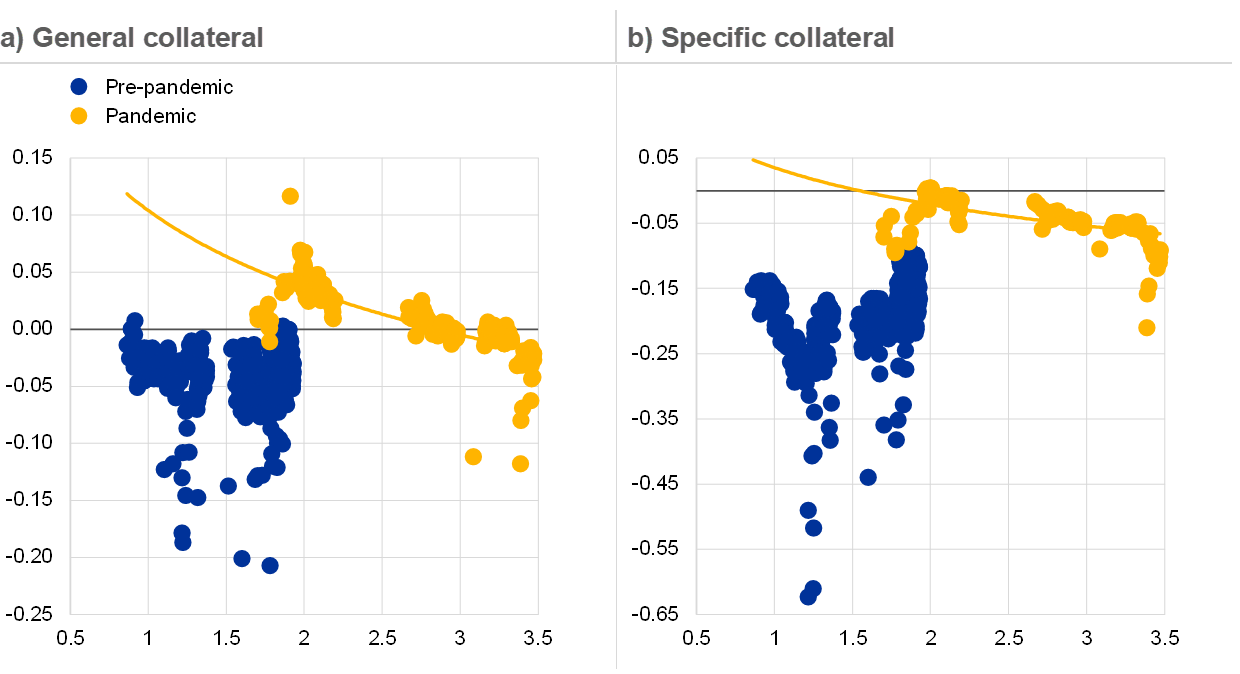
Sources: BrokerTec/MTS and ECB (liquidity statistics published in wire services).
Notes: The blue dots represent period before the COVID‑19 pandemic when excess liquidity was increasing (July 2016 – December 2018). The yellow dots represent the expansion of excess liquidity following the outbreak of COVID‑19 pandemic (March – December 2020). The vertical axis depicts daily volume-weighted average secured O/N, S/N and T/N rates spread versus the DFR. Horizontal axis reflects the daily excess liquidity in the euro area. Only government collateral.
The relationship between reporting dates and rates
Secured rates exhibit considerable seasonality, with rates moving sharply at period-end dates (see Chart 1.12). These moves may be attributed to the banks’ policy of avoiding trades that settle on reporting dates and therefore influence their balance sheet and collateral positions. Year-end pressures are particularly acute and coincide with a relatively less liquid time for the market. In order to disincentivise activity, market-makers set punitive rates for repo trades on period end dates. The direction of the move is driven by the desire to hold assets of the highest credit quality. The repo rates of collateral of higher-rated issuers generally fall as this high-quality collateral is in demand, while the repo rates for government bonds of issuers with relatively low ratings – even though they also account for 0% of risk-weighted assets – tend to rise (this latter pattern reversed in the third and fourth quarter of 2020). The 2019 year-end effect on rates was relatively contained for core countries, as the imbalance of cash and collateral was less pronounced than on previous occasions. The decline of repo rates over the 2020 year-end was strong, although in line with market expectations, due to the reduced availability of government bonds in the market in light of the net asset purchases under PEPP and increasing excess liquidity. In 2020 the repo rates of all the jurisdictions decreased due to the low-risk environment, high level of excess liquidity and the greater willingness of foreign investors to demand non-core collateral.
Chart 1.12
GC repo rate day-to-day moves at quarter-ends
(basis points)

Sources: BrokerTec, ECB calculations.
Note: Countries included are France (FR), Germany (DE) and Italy (IT).
Yield curve
Compared with two years ago, the yield curve has shifted downwards, while maintaining a mild upward slope (see Chart 1.13). For most maturity buckets, secured rates declined over the period under review, given the very accommodative monetary policy stance which eased funding conditions. The term structure of the weighted average repo rates is flat from overnight to one week and has a mild upward slope for longer tenors. Banks borrow cash at slightly lower rates than they lend it, as reflected in the bid-ask spreads. This spread increases as the maturity of the trade increases. At the peak of the COVID‑19 crisis secured rates remained contained, in contrast to rates in the unsecured segment.
Chart 1.13
Yield curve
(left-hand side: EUR billions; right-hand side: percentages)

Source: ECB (MMSR), ECB calculations.
Notes: COVID‑19 represents the period 17‑23 March 2020, reflecting the same period when the unsecured market experienced tension. The left-hand side axis and the bars represent the average daily volume per maturity. The right-hand side axis and the lines represent the volume-weighted average rate per maturity.
The yield curve exhibits segmentation based on trading counterparty type (see Chart 1.14). Rates for lending transactions with NFCs[5] were above those for banks and other financials for most maturities, although the slope of the yield curve is relatively flat. Interbank and other financial sectors show a similar pattern, but with short maturities at rates close to the DFR and an upwardly sloping yield curve. The benefit of using CCP clearing is also visible in a yield curve which is below that of bilateral equivalents. Trades cleared with CCPs have minimised counterparty risk, leading to a flat yield curve structure.
Chart 1.14
Yield curve per counterparty type
(left-hand side: EUR billions; right-hand side: percentages)
a) Lending

b) Borrowing
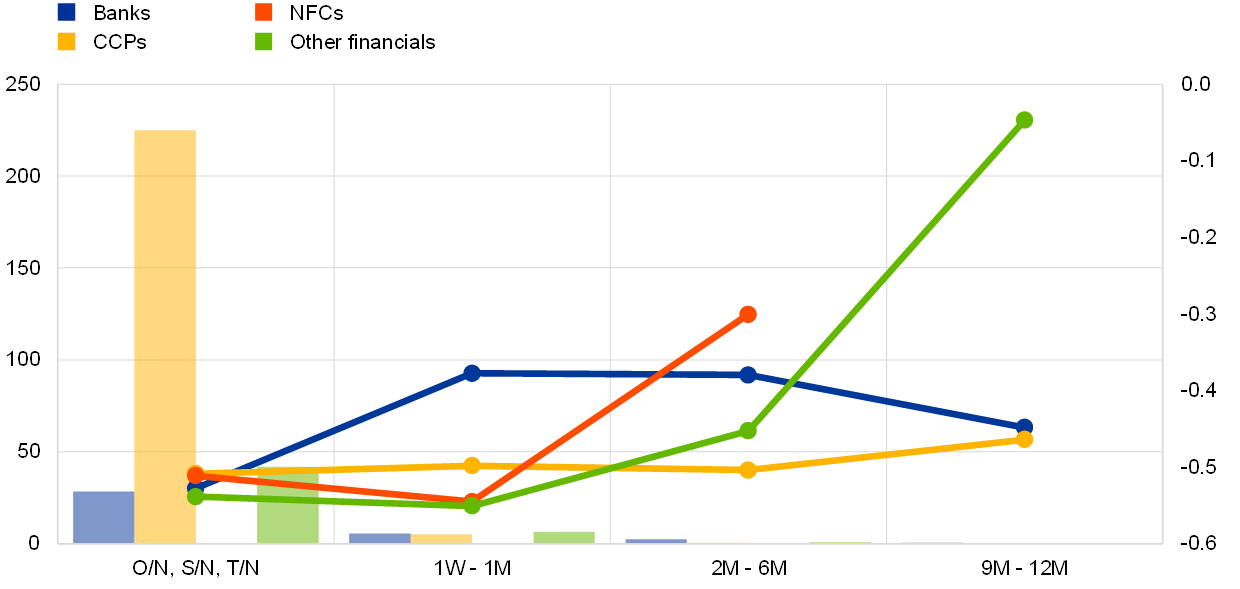
Sources: ECB (MMSR), ECB calculations.
Note: The left-hand side axis and the bars represent the average daily volume per maturity for each counterparty type. The right-hand side axis and the lines represent the volume-weighted average rate per maturity. Panel (a) plots the yield curve for lending transactions and panel (b) for borrowing transactions. The sample covers transactions from 2019 to 2020. Other financials include all financial corporations apart from banks and central banks. Confidential values are hidden.
1.4 Maturities
Transaction volume per maturity
Most secured transactions are concentrated in the one-day maturity bucket (see Chart 1.15)[6]. The cumulative share of maturities up to one-month of overall secured lending and borrowing remains very high (95% in 2020). Among transactions with a one-day maturity there was a small decline in spot/next lending and borrowing – this was offset by a growing share of overnight transactions. Maturities of one month or longer are used more widely in lending than in borrowing activities.
Chart 1.15
Volumes by maturity bucket over time
(EUR billions)

Source: ECB (MMSR).
Note: O/N – overnight; S/N – spot/next, T/N – tomorrow/next. Confidential values are hidden.
Trades with a shorter maturity profile tend to be concentrated in CCPs, while those with longer tenors are traded bilaterally (see Chart 1.16). CCPs account for around 75% of one-day maturity trades, but for only around 20% of trades with longer tenors. Market intelligence suggests that trading higher volumes at shorter maturities incentivises banks to net off their positions with CCPs in order to gain efficiency in their use of collateral.
Chart 1.16
Share of centrally cleared secured trades by maturity
(percentages)

Source: ECB (MMSR).
Notes: Share of total secured transaction volume over the 2018‑20 review period – split by counterparty type and maturity.
O/N – overnight; S/N – spot/next; T/N – tomorrow/next.
Outstanding volume per maturity
The stock of secured transactions is concentrated in the one-week to three-month maturity range, and accounts for around 40% of outstanding trades (see Chart 1.17). One-day maturity trades account for around 20% of outstanding amount, while the remaining 40% are trades with a maturity longer than three months and forward contracts. Over the review period the volume-weighted average maturity of secured transactions increased slightly, from around seven days in 2018 to over eight days in 2020.
Chart 1.17
Share of total outstanding amount by original maturity
(percentages)

Source: ECB (MMSR), ECB calculations.
Notes: The outstanding amount is a snapshot taken at 15 September 2020 in order to avoid reporting dates. The outstanding amount transforms the daily transaction volumes (flows) into a stock variable based on maturity dates.
1.5 Counterparties
CCP clearing
Around 70% of secured transactions were centrally cleared (see Chart 1.18). The remaining share was traded bilaterally through direct trading or via brokers. The analysis shows equivalent shares of CCP-cleared business in both borrowing and lending transactions.
Secured transactions were cleared via three major CCPs: LCH SA in France, CC&G in Italy and Eurex Clearing in Germany. During the review period, LCH moved their RepoClear business from LCH Ltd in the United Kingdom to LCH SA in France[7]. The move took place in February 2019, during the process of the United Kingdom’s withdrawal from the EU, which was completed in January 2020. LCH suspended the clearing of euro repo in LCH Ltd from 20 March 2020 onwards.
Chart 1.18
Secured transaction volumes per counterparty type and location
(EUR billions)
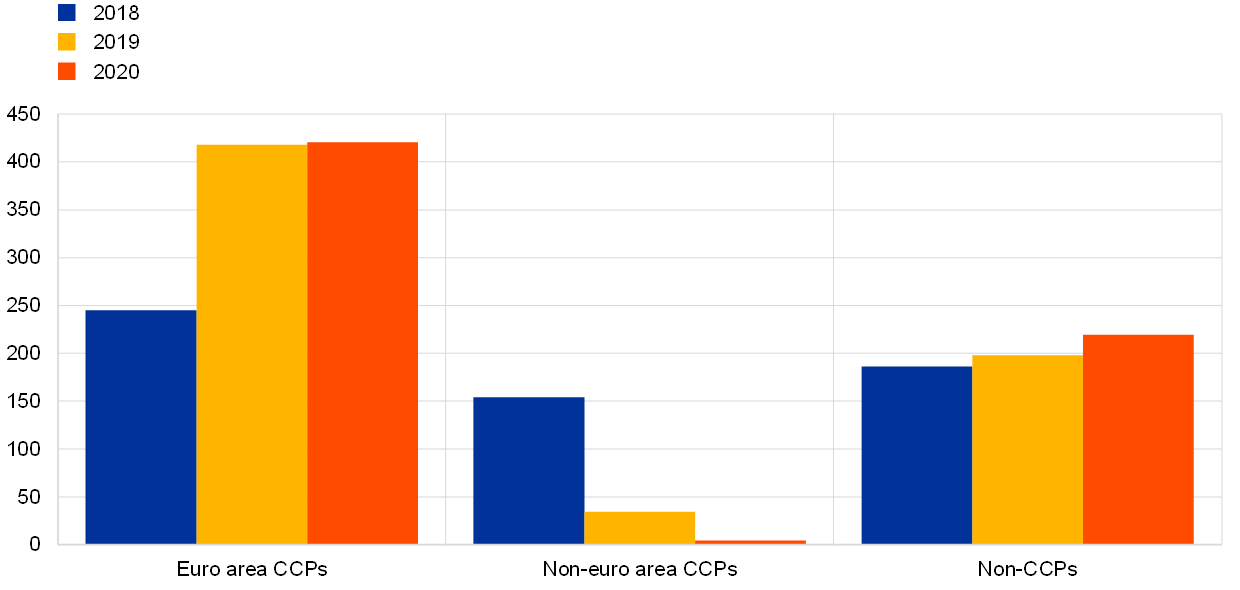
Sources: ECB (MMSR) and ECB calculations.
Notes: Average daily volume of paid and received transactions.
Flows by sector
Around 30% of trades are not centrally cleared – this share increased slightly over the course of the review period (see Chart 1.19). Banks have traditionally accounted for the largest share of this volume of bilateral transactions (41% in 2019). However, secured bilateral trading with investment funds, MMFs and insurance companies increased notably in 2020. This activity represented 39% at the end of 2020 as opposed to 32% the previous year. Taken together, these counterparties have now almost overtaken banks as the largest counterparty sector within bilateral trading. The increase in activity is consistent with a desire to hold more liquid instruments and higher cash buffers since the COVID‑19 pandemic began. MMFs and investment funds tend to be net cash lenders, using the secured segment to place cash. Insurance companies are generally net borrowers of cash in the repo segment.
Chart 1.19
Bilateral secured transactions by counterparty sector
(EUR billions)

Source: ECB (MMSR).
Note: Only non-CCP trades. IFs – investment funds, MMFs – money market funds, ICs – insurance companies. Government category consists of both general government and central banks. Confidential values are hidden. Average daily transaction volumes are plotted at a bi-weekly frequency.
Flows by jurisdiction
There was a significant increase in the share of secured transactions executed in the euro area over the review period (see Chart 1.20). This may be largely attributed to the relocation of LCH’s RepoClear service from the UK to France, leading to an increase in domestic and cross-border transactions within the euro area. This move away from international counterparties has also been seen in non-cleared transactions. Euro area trading now accounts for most of the trading in both the cleared and the bilateral segments.
Chart 1.20
Secured transactions by counterparty location
(percentages)

Sources: ECB (MMSR), ECB calculations.
Notes: A large reduction in international trades was observed on 19 February 2019.
2 The unsecured segment
Activity in the unsecured segment has remained subdued but stable over the last two years, with a trading shift towards shorter maturities during the pandemic. The disruption in unsecured trading in the longer tenors during COVID‑19 has been driven largely by temporary tensions in the issuance of STS. Arbitrage opportunities in the FX swap segment have also been mentioned as a possible reason.
Owing to the high level of excess liquidity and the forward guidance, unsecured rates have gradually moved below the DFR for the shorter maturities. The euro short-term rate (€STR), which includes overnight borrowing transactions with banks and non-banks, has also edged below the DFR since its initial publication in October 2019. As non-banks do not have access to the Eurosystem’s deposit facility they tend to trade with euro area banks in order to “park” their excess liquidity. Since euro area banks need to cover the regulatory costs associated with the acceptance of unsecured deposits from non-banks, this trade pattern has led to the €STR staying stable at 5‑6 basis points below the DFR also throughout the pandemic crisis.
The stability of unsecured rates with short tenors during the pandemic has stood in contrast to the sharp and persistent rise in term rates and EURIBOR. Commercial paper rates also rose quickly as demand for STS paper from MMFs froze at the peak of the pandemic. As the issuance of commercial paper is economically equivalent to the collection of unsecured deposits (i.e. their rates embed risk premia to compensate for credit risk of borrowers), the relevant transactions fall within the economic reality that EURIBOR seeks to measure. Therefore, tensions in the commercial paper market were also visible in the unsecured term rates. Moreover, the increase in three-month LIBOR during the pandemic created an incentive to borrow funds in the euro unsecured market and swap these into US dollars, which resulted in further upward pressure on three-month EURIBOR. The impact of the STS and FX swaps segments on EURIBOR was amplified by the usual low levels of term unsecured trading activity.
Both the Eurosystem and the Federal Reserve System reacted decisively to the tensions in financial markets – tensions which extended well beyond the term money market. Central banks’ policy interventions effectively eased the liquidity strains observed in the spring of 2020 and supported market functioning by providing ample liquidity to banks. These interventions prevented self-reinforcing dynamics from taking hold in key financial market sectors, such as investment funds and MMFs, and at the same time kept unsecured turnover low as market funding was to a large extend replaced by central bank funding. EURIBOR has continued to decline in recent months and is currently at historically low levels, below the DFR. The yield curve in the unsecured money market has flattened significantly, even in comparison with the pre-pandemic period.
2.1 Volumes
2019‑20 trends
The unsecured segment represented 14% of euro money market turnover in 2020, predominantly reflecting banks’ borrowing transactions with non-banks (see Chart 2.1). Volumes in the money market have remained relatively robust since the GFC, supported by the increased participation of non-banks. The Eurosystem’s APPs have been increasing the amount of liquidity held outside the banking system when assets are acquired from counterparties different than euro area banks. These entities place a large part of the cash received from the Eurosystem back with their euro area counterparts to access the central bank balance sheet and, as a result, activity in both the unsecured and secured segments increased. Only 15% of volume was due to interbank activity within the euro area.
From a historical perspective unsecured activity notably declined, as the bulk of money market transactions shifted to the secured segment where centrally cleared solutions prevailed. The ample liquidity and the regulatory costs[8] associated with unsecured trading resulted in a continued preference by counterparties – especially banks – for secured trades.
Chart 2.1
Market share per segment
(EUR billions)
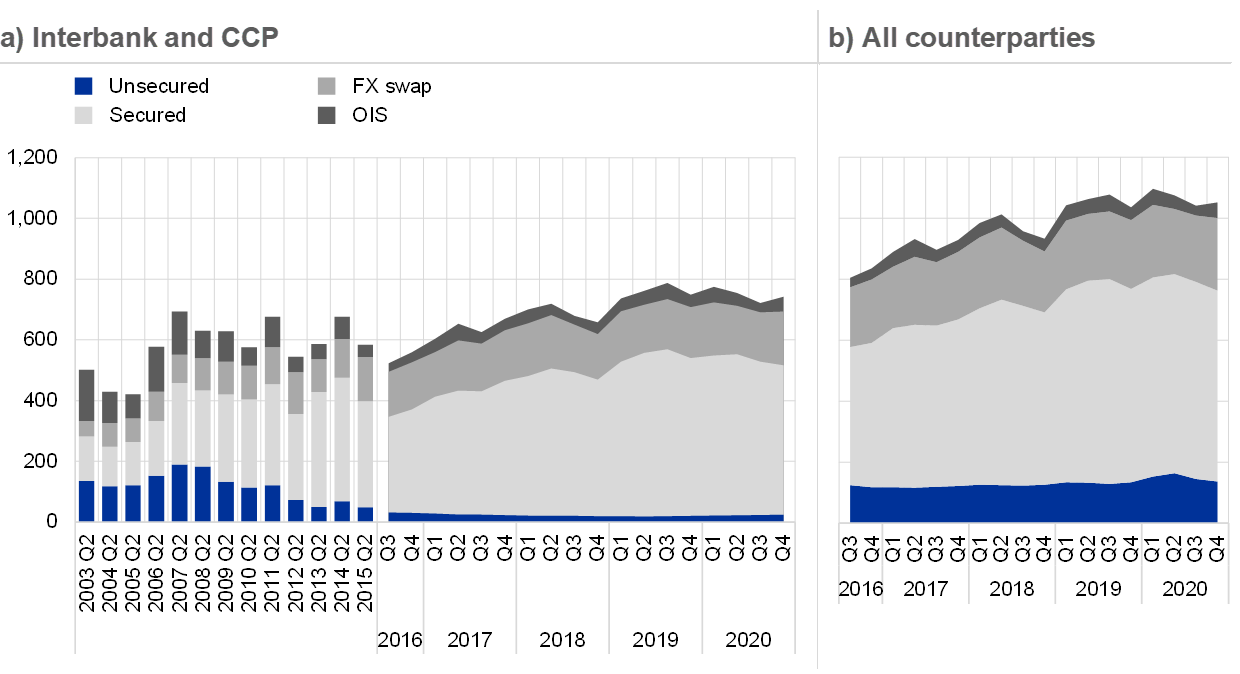
Sources: Panel (a) – ECB (euro money market survey) until 2016 and ECB (MMSR) from 2016 onwards; Panel (b) – ECB (MMSR).
Notes: Average daily transaction volumes. “FX” refers to the Foreign Exchange segment, while “OIS” refers to the Overnight Index Swap segment. Panel (a) includes only interbank counterparties and CCPs; Panel (b) includes all reported counterparties. The bars show euro money market survey data for 38 overlapping reporting agents and retropolated data for the 14 MMSR reporting agents not covered in the survey. The retropolation increases the series by a fixed proportion representing the 14 missing reporting agents’ market share at Q3 2016 (15% of the unsecured segment). Two confidential datapoints have been interpolated. The OIS segment excludes novations in MMSR data.
Activity in the unsecured segment has remained subdued but stable over the last two years, with a trading shift towards shorter maturities during the pandemic (see Chart 2.1 above and Chart 2.2). The outstanding volume in the unsecured segment was €326 billion in the period 2019‑20, with a daily average transaction volume of €140 billion. During the pandemic, short-term unsecured transactions have increased while volumes in longer tenors have shrunk. Unsecured transactions above one week represented 5% at the end of 2020, compared with 8% before the pandemic and 10% two years earlier.
The very low volumes of transactions in the term unsecured market led to a sharp rise in EURIBOR fixings during the peak of the COVID‑19 crisis. The reduction in EURIBOR actual unsecured transactions (Levels 1 and 2) at the peak of the COVID‑19 crisis forced the rate calculation to rely more on expert judgement and internal models for credit risk (Level 3). According to EMMI data, the contribution from Level 3 increased from 71% of the total in January 2020 to 82% in March 2020 for three-month EURIBOR, in line with the decrease in term unsecured turnover. Furthermore, the increase in LIBOR rates also exerted pressure on EURIBOR fixings because it was more convenient to borrow funds in euro and swap them in US dollars.
Chart 2.2
Outstanding amount borrowed and lent by euro area banks
(left-hand side: EUR billions, right-hand side: percentages)
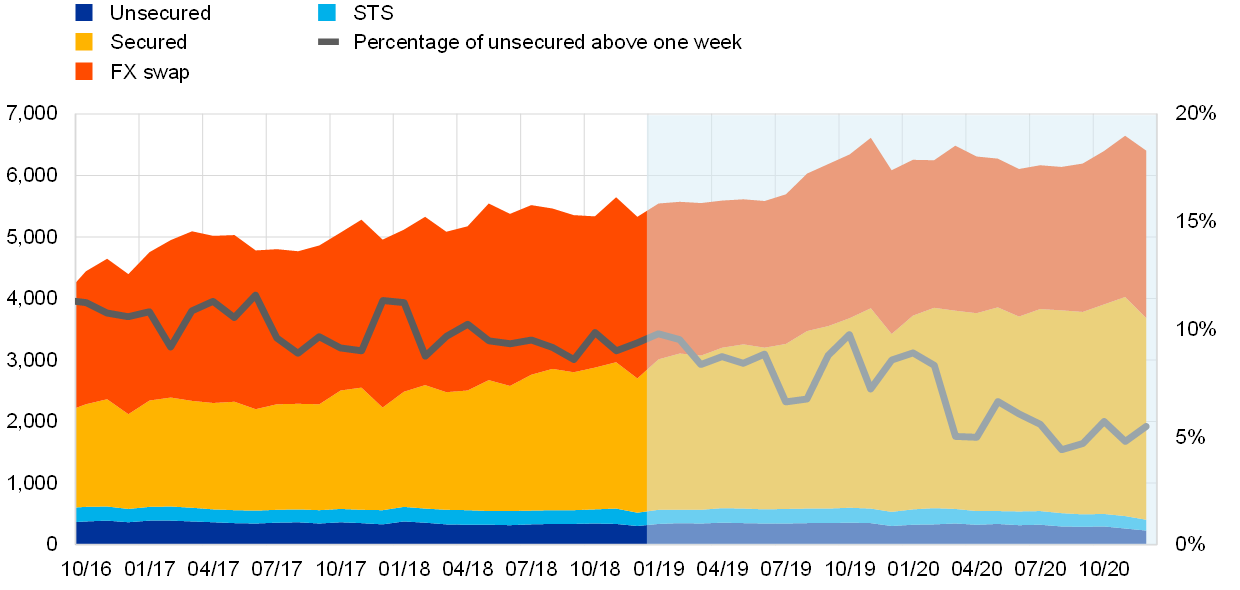
Sources: ECB (MMSR for Unsecured and Secured data), CSDB for STS data.
Notes: “Unsecured” represent the outstanding amount borrowed and lent by MMSR banks, excluding any short-term debt instruments. The line shows the monthly average share of unsecured deposits transaction volume with maturity above one week. “Foreign exchange swap” represents buying and selling the EUR/USD currency pair. “STS” data refer to the outstanding amount issued or held by euro area banks (only in EUR currency). Tenors up to one year. The stacked areas show the amounts outstanding on the last day of each month.
Borrowing transactions dominated activity by euro area banks in the unsecured segment, with banks channelling the excess liquidity to the Eurosystem as excess reserves or by using the deposit facility (see Chart 2.V.3). Borrowing volumes were significantly larger than lending volume[9], which reflected the intermediary position of the largest euro area banks in the euro money market, channelling reserves from non-banks that do not have access to the Eurosystem deposit facility. Despite the notable increase in excess liquidity, overall borrowing in the unsecured segment did not rise significantly, showing the declining role of this segment in the management of liquidity by large banks.
Interbank lending volumes remained marginal despite increasing temporarily following the introduction of the two-tier system in October 2019 (see Chart 2.3). Banks with insufficient excess liquidity to cover their two-tier system allowances borrow from banks which have liquidity which exceeds their own allowances. While most of this trading activity took place in the secured market[10], domestic liquidity redistribution also happened through the unsecured segment, especially in Germany. However, this increase was only temporary because banks receiving market liquidity achieved more favourable conditions in the TLTRO III monetary policy operations offered later by the Eurosystem.
Chart 2.3
Trends in daily transaction volume
(EUR billions)

Source: ECB (MMSR).
Note: Excludes commercial paper, certificates of deposit and floating rate notes. Last date is 8 January 2021 for visualising year-end effects. Confidential values are hidden. The period under review is indicated by a light blue background.
The relationship between excess liquidity and volumes
The data show that the liquidity injection is correlated with reduced interbank lending activity, while it is almost neutral for wholesale borrowing (see Chart 2.4). Prior to the pandemic, an increase in excess liquidity coincided, on average, with a notable decrease in unsecured lending volumes. Unsecured wholesale borrowing on average are not so responsive to the Eurosystem’s liquidity injections. Throughout the COVID‑19 crisis, a similar negative correlation between unsecured interbank lending volumes and the growth of excess liquidity has been observed. Nevertheless, the trend for excess liquidity is not strongly correlated with unsecured wholesale borrowing, either in the pre-pandemic period or during COVID‑19 times.
Chart 2.4
Correlation between unsecured volumes and excess liquidity
(y-axis: EUR billions; x-axis: EUR trillions)
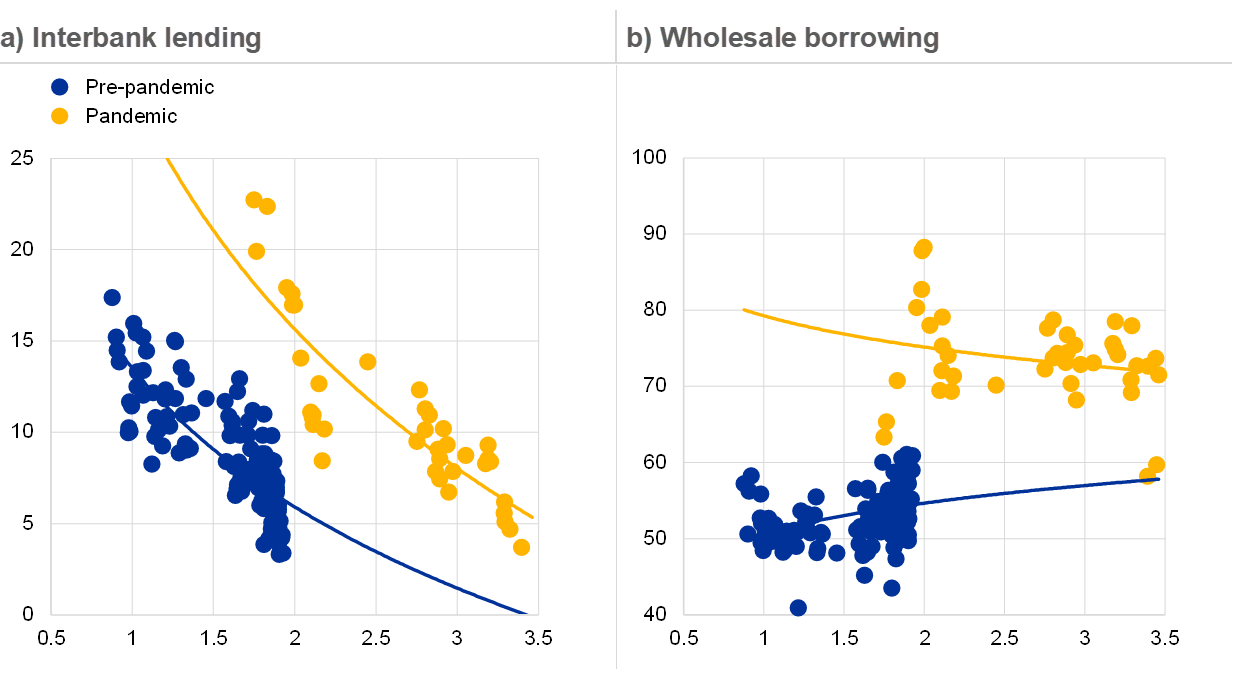
Sources: ECB (MMSR), ECB (liquidity statistics published in wire services).
Notes: The blue dots represent the period before the COVID‑19 pandemic when excess liquidity was increasing (July 2016 – December 2018). The yellow dots represent the expansion of excess liquidity following the outbreak of the COVID‑19 pandemic (March – December 2020). X-axis: weekly average euro excess liquidity; y-axis: weekly average unsecured O/N, S/N and T/N volumes.
The relationship between reporting dates and volume
Borrowing transactions declined significantly at year-ends compared with quarter-ends, when the effects were less pronounced and occasionally resulted in increases in volume (see Chart 2.5). Transaction volumes usually drop at reporting dates for regulatory reasons, i.e. because of year-end “window-dressing” aimed at reducing the amount of bank levies and minimising regulatory costs. In the review period, borrowing transactions declined markedly at year-ends while interbank lending activities barely changed. By contrast, unsecured trading volumes showed the opposite trend over quarter-ends: while unsecured lending turnover always decreased to some extent, borrowing volumes rose at four out of six quarter-ends, albeit only slightly.
Chart 2.5
Changes in unsecured volumes for quarter-ends by transaction type
(EUR billions)

Sources: ECB (MMSR).
Notes: The change in transaction volume of the one-day maturity transactions (O/N, S/N, T/N) covering quarter-end and the prior working day. Excludes commercial paper, certificates of deposit and floating rate notes.
2.2 Rates
€STR, a new benchmark rate
The €STR reflects the overnight cost of wholesale euro borrowing for euro area banks with financial counterparties – it was first published by the ECB on 2 October 2019. The rate was introduced to provide a robust reference rate for euro financial markets, is compliant with the International Organisation of Securities Commissions’ Principles for Financial Benchmarks and fulfils the three main criteria of a benchmark rate, i.e. rate accuracy, data sufficiency and rate representativeness. The €STR is published daily and is computed using a trimmed volume-weighted average rate for the eligible transactions settled on the previous TARGET2 business day.[11] In September 2018 the private sector working group on euro risk-free rates (WG RFR)[12] recommended that the €STR should replace the Euro Overnight Index Average (EONIA), which will be discontinued on 3 January 2022. However, the €STR has been the de facto reference rate for short-term rates in the euro area since October 2019, when the EONIA methodology was redefined as the €STR plus a fixed spread of 8.5 basis points.
The €STR has been stable since its launch in October 2019 (see Chart 2.6). Since its inception, the €STR has fluctuated in a narrow range between ‑58.3 basis points and ‑51.1 basis points, while volumes have averaged €39.2 billion in a range between €13.5 billion and €59.3 billion. The relatively stable negative spread versus the DFR reflects the stable nature of overnight deposit pricing and the smoothing effect of trimming (which removes outlier transactions).
Three main trends can be identified since the €STR was introduced. First, when the two-tier system was implemented the €STR hovered at around ‑53 basis points (around 2 basis points above the levels registered in October 2019), reflecting the higher rates paid by some banks to borrow liquidity to fulfil their exempt tier. Volumes remained at an average of €30 billion, with limited daily deviations. Second, the COVID‑19 outbreak led to a deterioration in risk sentiment which caused MMFs to hoard cash in banks deposits and the €STR to rise slightly further up, reaching ‑52 basis points at around the end of March 2020. At the same time, volumes increased notably, reaching a peak of €59 billion on 6 April 2020. Third, the normalisation period saw a large increase in central bank balance sheets and improved risk sentiment (since May 2020), when the €STR averaged ‑55 basis points in the second half of 2020, with an average volume of €42 billion.
Chart 2.6
ECB unsecured benchmark rate and volume
(left-hand side: percentages, right-hand side: EUR billions)

Source: ECB, ECB calculations.
Notes: Until 1 October 2019 the ECB benchmark rate was EONIA, representing the overnight interbank lending unsecured activity. Afterwards, the ECB benchmark rate became the €STR, representing the overnight borrowing by euro area banks from all counterparty types in the unsecured segment.
2019‑20 trends
Overnight borrowing rates remained broadly stable, hovering at around 5‑6 basis points below the DFR, while lending rates, especially those for longer maturities, soared during the COVID‑19 crisis. As mentioned in the previous section, overnight borrowing costs remained anchored to the DFR and were largely unaffected by the main events which took place during the period under review. The low dispersion across short maturities borrowing rates stood in contrast to developments in term rates (especially those for lending transactions) as reflected in EURIBOR[13], which increased considerably at the beginning of the pandemic. Interbank overnight lending rates were also affected by the crisis, with the volume-weighted average rate increasing by 7 basis points during the market tensions in March.
The rise in EURIBOR pointed to tensions in other segments of the money market (see Chart 2.7). At the end of April 2020, rates in the three-month and twelve-month maturities reached ‑20 basis points and ‑7 basis points respectively and were substantially higher than their pre-pandemic levels. Movements in term unsecured trading were largely driven by three factors. First, arbitrage opportunities in the FX swap segment caused an increase in three-month LIBOR during COVID‑19, which created a temporary incentive to borrow funds in the euro unsecured segment and swap these into US dollars. This resulted in upward pressure on three-month EURIBOR. Second, the low levels of market liquidity at longer horizons forced the panel banks under the EURIBOR’s hybrid methodology to also rely on expert judgement. The latter was likely based on estimates of credit risk derived from internal models. Third, as commercial paper rates are used as a Level 1 contribution for the pricing of EURIBOR under the hybrid methodology, tensions in the commercial paper market also affected rates in the term unsecured money market.
Chart 2.7
EURIBOR and O/N lending unsecured rates vis-à-vis STS rates
(left-hand side: percentages; right-hand side: EUR billions)
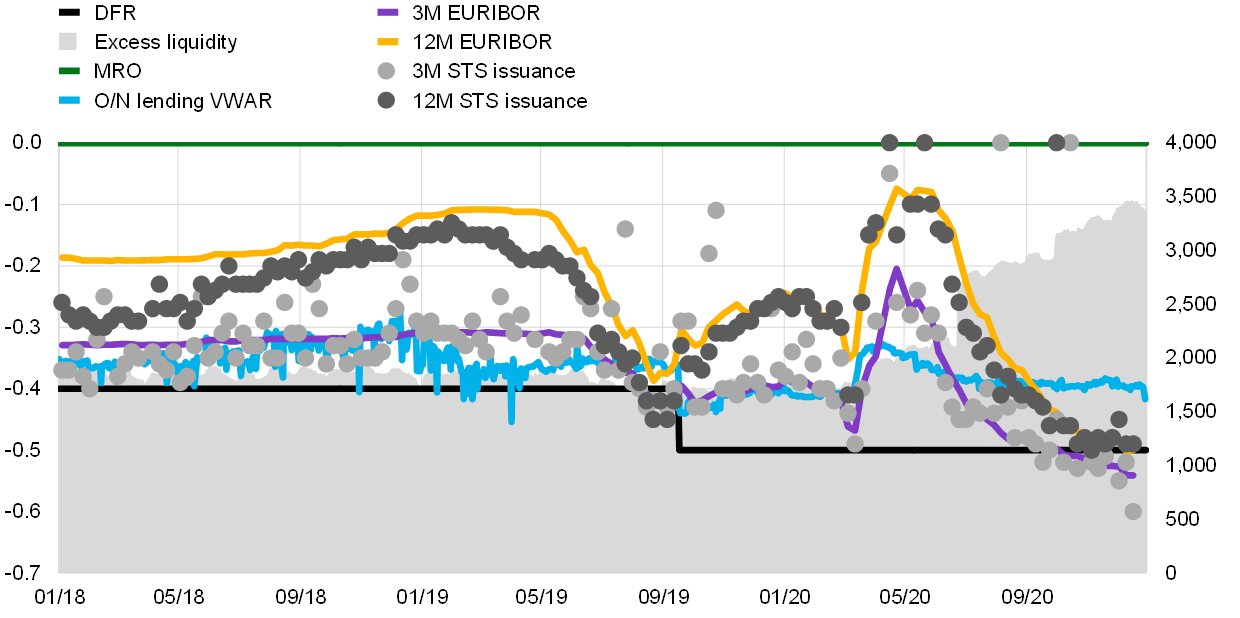
Sources: STS data (Banque de France), ECB(MMSR), ECB calculations.
Notes: “STS” stands for short-term debt issuance based on NEU CP data. EURIBOR refers to the average interest rate at which euro area banks offer short-term lending in the interbank unsecured segment. O/N lending is a volume-weighted average unsecured rate from MMSR.
The unsecured term rates respond both to expected changes in the Eurosystem’s policy stance, such as expectations of a DFR cut in 2019, and to easing measures introduced by the Eurosystem in March 2020. The yield curve inverted briefly, amid significantly lower term rates, in August 2019 when markets were pricing in the very high likelihood of an imminent DFR cut (September 2019). After the rate cut the curve’s shape gradually normalised until the COVID‑19 outbreak, when longer-term rates started to increase visibly amid the market stress. Starting from the end of April, the expanded Eurosystem measures implemented in response to the pandemic shock, combined with improved market conditions, brought significant relief to unsecured borrowing rates, which started to fall across maturities. After June the notable rise in excess liquidity led rates across the unsecured yield curve to drop below pre-pandemic levels, with the most notable declines recorded for term rates. Another example is the spread between overnight and twelve-month rates, which reached 29 basis points at the end of May 2020 compared to 10 basis points in January 2020. These developments were in line with what had been observed in other market segments, such as the commercial paper and certificate of deposit market, as reflected by EURIBOR’s dynamics.
The relationship between excess liquidity and rates
Liquidity injections during the COVID‑19 crisis have coincided with downward pressure on short-term unsecured rates (see Chart 2.8). The increase in excess reserves during the pandemic has been negatively correlated with both lending and borrowing rates. In the case of the borrowing rate, the negative correlation seems to have softened compared with previous periods of large liquidity injections between 2016 and 2018.
Chart 2.8
Correlation between the unsecured rate spread versus the DFR and excess liquidity
(y-axis: percentages; x-axis: EUR trillions)
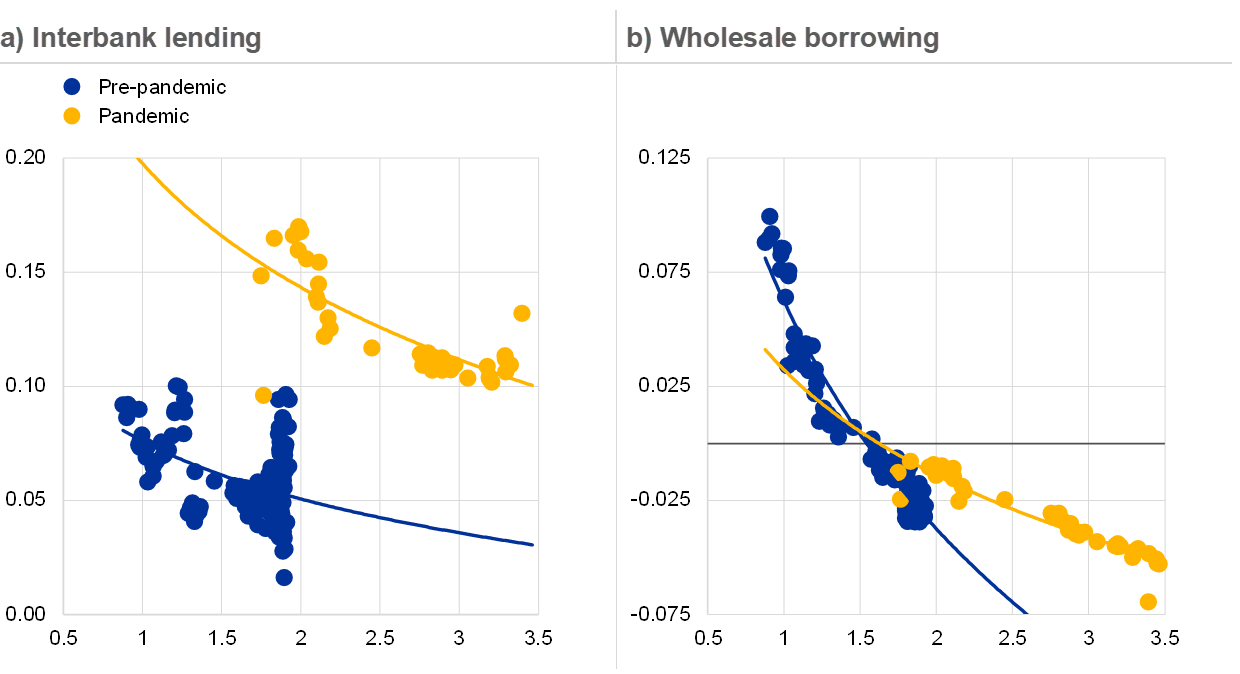
Sources: ECB (MMSR), ECB (liquidity statistics published in wire services).
Notes: The blue dots represent the period before the COVID‑19 pandemic when excess liquidity was increasing (July 2016 – December 2018). The yellow dots represent the expansion of excess liquidity following the outbreak of the COVID‑19 pandemic (March – December 2020). x-axis: weekly average euro excess liquidity, y-axis: weekly average volume-weighted average unsecured O/N, S/N and T/N rates’ spread versus the DFR.
The relationship between reporting dates and rates
Unsecured overnight rates exhibit seasonality at quarter-ends (see Chart 2.9). Close to regulatory reporting dates, banks apply more punitive prices for deposits. Their objective is to disincentivise borrowing transactions and reduce the size of their balance sheets in order to improve prudential ratios and optimise bank levies. As a result, unsecured borrowing rates regularly decline at quarter-ends and, sometimes, more significantly at year-ends. In the period under review this result could be observed in most quarters.
Chart 2.9
Unsecured rates’ day-to-day moves at quarter-ends
(basis points)
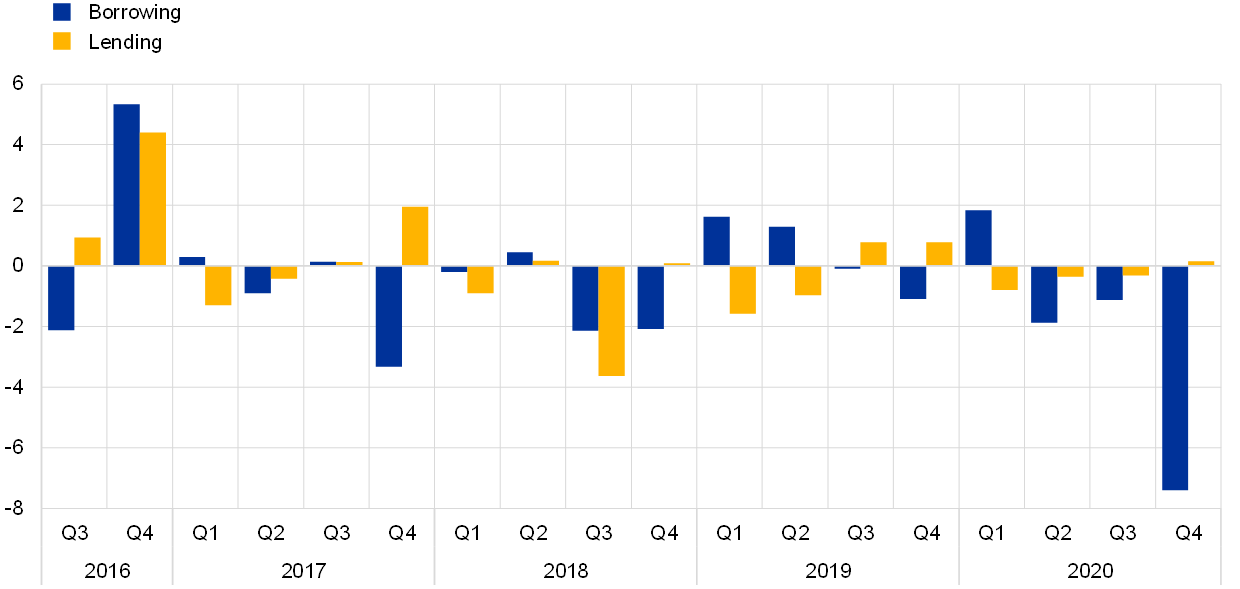
Source: ECB (MMSR), ECB calculations.
Notes: The difference in volume-weighted average rates on the days covering quarter-ends and the prior working day. Only one-day maturity transactions (O/N, S/N, T/N). Excludes commercial paper, certificates of deposit and floating rate notes.
The high level of excess liquidity in the system during the second half of 2020 exacerbated the quarter-end effect on the €STR. Elevated excess liquidity conditions, especially after the settlement of TLTRO III.4, incentivised reporting agents to reduce borrowing from the market at quarter-ends, minimising balance sheet costs. In this vein, the €STR dropped by 1.4 basis points to ‑57.1 basis points on 30 September, and by as much as 2.8 basis points to an all-time low of ‑58.3 basis points on 31 December 2020 – the largest month-end movement on record.
Yield curve
The yield curve in the unsecured segment steepened temporarily in March 2020 but by the end of 2020 the yield curve was lower and flatter than two years earlier (see Chart 2.10). The lowering of the curve was due to the DFR cut in September 2019, while the flattening was a consequence of the Eurosystem’s expansion of the provision of liquidity as a response to the tensions in financial markets due to the COVID‑19 crisis as well as the expectations for negative interest rates for a prolonged period. The flattening mainly affects the six-month to twelve-month maturity bucket. The Eurosystem’s increase of excess liquidity had a sustained downward effect on money markets in the euro area, affecting longer maturities in particular. EURIBOR continued to recede in the second half of 2020 and stood at historically low levels at the end of that year.
Chart 2.10
Yield curve
(left-hand side: EUR billions; right-hand side: percentages)

Source: ECB (MMSR), ECB calculations.
Notes: COVID‑19 represents the period 17‑23 March 2020, when the unsecured market experienced tensions. The remaining values are daily averages over the quarter. The right-hand side axis and the bars represent the average daily volume (STS data included) per maturity. The left-hand side axis and the lines represent the volume-weighted average rate per maturity.
The yield curve exhibits segmentation on the trading counterparties (see Chart 2.11). Borrowing rates from NFCs are generally higher than those for counterparties belonging to the financial sector. Looking at the one-day maturity bucket, deposit trades with other financial institutions are, on average, around 4 basis points below the DFR, while trades with government entities and corporates show a positive spread versus the DFR. Transactions with NFCs have always been executed at higher rates than in the interbank market. Euro area banks reported deal rates above the DFR for trades conducted with NFCs as well as those with government entities. Nevertheless, amid increasing levels of excess liquidity, the spread between borrowing rates from financial institutions and NFCs tightened during 2020, from 25 basis points in the first quarter of 2020 to 15 basis points in the third quarter of 2020.
Chart 2.11
Unsecured yield curve per counterparty
(left-hand side: EUR billions; right-hand side: percentages)

Source: ECB (MMSR), ECB calculations.
Notes: The left-hand side axis and the bars represent the average daily volume per maturity. The right-hand side axis and the lines represent the volume-weighted average rate per maturity. The chart includes both borrowing and lending transaction volumes for banks. Only borrowing unsecured transactions with NFCs and other financial corporations are reported in MMSR. The sample covers transactions from 2019 to 2020. Confidential values are hidden.
2.3 Maturities
Transaction volume per maturity
Most unsecured transactions are executed overnight, accounting for 67% of the overall unsecured trades in 2020 (see Chart 2.12). These are deposits as well as call accounts or call money, i.e. money lent by banks that must be repaid on demand. There are no significant differences with regard to maturity distribution between borrowing and lending transactions, except for the fact that the turnover of the latter is much lower. The preference for short-term transactions has been even more pronounced during the COVID‑19 crisis.
Chart 2.12
Unsecured volumes by maturity over time
(EUR billions)
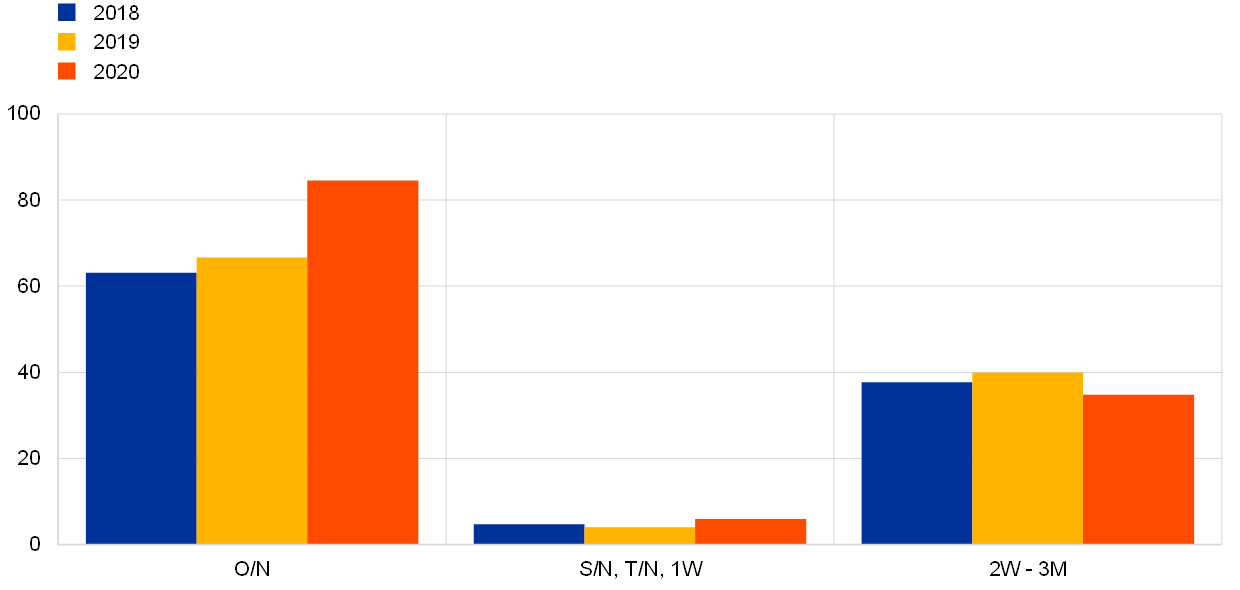
Source: ECB (MMSR).
Notes: The chart shows borrowing and lending volumes. Commercial paper, certificates of deposit and floating rate notes are excluded. Maturities above three months are hidden for reasons of confidentiality.
Outstanding volume per maturity
The stock of unsecured transactions is concentrated in the six-month to one-year maturity tenors (see Chart 2.13). In contrast to the distribution of transaction volume, one-day maturity trades only account for around 20% of outstanding volume, the remaining 80% being trades with a maturity longer than one week, including a large proportion of contracts for six months and beyond. Over the review period the volume-weighted average maturity decreased substantially, from nine days at the beginning of 2019 to five days at the end of 2020, in a trend that has continued since MMSR data was first produced in 2016, when the average maturity stood at ten days.
Chart 2.13
Share of total outstanding amount by original maturity
(percentages)

Source: ECB (MMSR), ECB calculations.
Notes: The outstanding amount is a snapshot taken at 15 September 2020 in order to avoid reporting dates. The outstanding amount transforms the daily borrowing and lending transaction volumes (flows) into a stock variable based on maturity dates. Commercial paper, certificates of deposit and floating rate notes are excluded.
2.4 Counterparties
Flows by sector
While the share of interbank activity remained very limited, unsecured borrowing activity increased slightly – from 10% to 12% – in the period under review (see Chart 2.14). The largest share of euro area banks’ unsecured borrowing transactions took place with NFCs and other financials, with each accounting for 25%. Moreover, it is worth mentioning that unsecured borrowing business with governments and MMFs increased notably between 2019 and 2020, as did interbank lending during the same period.
Chart 2.14
Unsecured transaction volumes by counterparty sector
(EUR billions)

Source: ECB (MMSR).
Notes: Lending volume is reported only for bank counterparties in MMSR data. Commercial paper, certificates of deposit and floating rate notes are excluded.
Activity with MMFs has increased since the March tensions surrounding COVID‑19. Focusing on borrowing transactions, MMFs have continued to increase their relative trading volume in the unsecured sector. During the second quarter of 2020, these represented 12% of total unsecured trading volume, compared with 4% at the end of 2018. The increase related partly to the dynamics which emerged during the COVID‑19 crisis, when MMFs opted to redirect funds away from holdings of commercial paper and certificates of deposit towards short-term money market (unsecured and secured) transactions, in order to increase their liquidity buffers.
Flows by jurisdiction
Over time, excess liquidity tended to accumulate in specific banks located in a few euro area countries, independently of how the liquidity had originally been provided by the Eurosystem (see Chart 2.15). The liquidity provided through Eurosystem TLTRO III operations was more evenly distributed among euro area countries than had been the case for previous TLTRO series. However, Eurosystem APPs did not lead to a proportional increase in excess liquidity in the jurisdictions of the securities issuers. While the geographical distribution of purchases closely reflected national central banks’ (NCBs) share of the ECB’s capital key, more than half of the purchases were with counterparties belonging to banking groups whose head office was located outside the euro area. In addition, within the euro area the management of euro-denominated liquidity is concentrated in specific locations. For example, custodians and clearing institutions that process Eurosystem asset purchases are typically located in Belgium, Germany or France. Liquidity from the APP and PEPP placed in cash accounts may circulate further, while unused balances are likely to be swept into TARGET2 accounts at the end of the business day. As a result, excess liquidity tends to accumulate in specific banks of few euro area countries over time, seemingly independently of how the liquidity is provided by the Eurosystem. In addition, liquidity needs according to autonomous factors vary greatly between NCBs. Unsecured inflows into the euro area come either from entities operating in financial centres in Germany, Luxembourg and the United Kingdom or from foreign banks in the United States and Japan and international banks based in Poland. The main recipients of the liquidity are MMSR reporting banks in Germany, France and Benelux.
Chart 2.15
Overnight unsecured transaction volumes across jurisdictions
(nodes: total volumes per area, connections on the top: lending flows, connections on the bottom: borrowing flows)

Source: ECB (MMSR).
Notes: The chart shows borrowing and lending transactions. The blue lines represent flows within the euro area, the green lines represent international connections.
Cross-border trading has increased over the past two years (see Chart 2.16). In terms of borrowing, the share of volume traded between counterparties belonging to the same country oscillated between 50% and 60% in 2018 and 2019, while it declined to around 46% during 2020. Meanwhile, the share of euro area cross-border trading rose steadily after 2018, and especially in 2020, amid higher activity with MMFs located in Ireland, France and Luxemburg. On the lending side, the introduction of two-tier system led to an increase in the domestic share of transactions. German counterparties traded more actively in the interbank market in order to fill their exempt tiers – this happened mainly within banking networks (Verbünde), while similar patterns were not observed in other jurisdictions.
Chart 2.16
Unsecured borrowing transactions by counterparty location
(percentages)
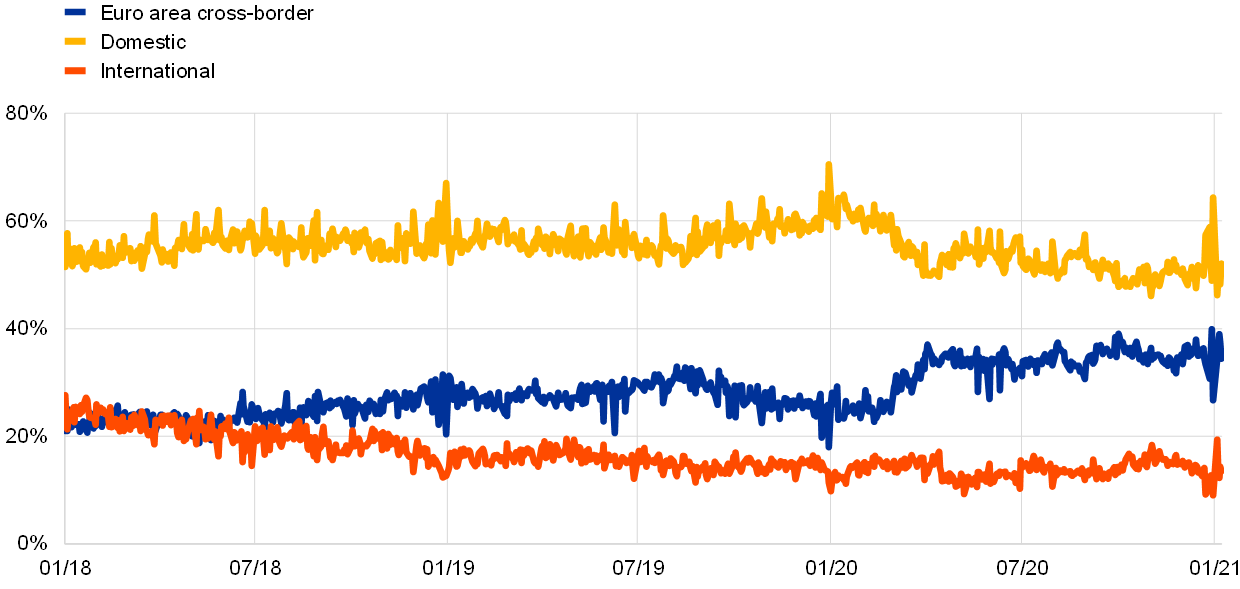
Sources: ECB (MMSR), ECB calculations.
Notes: Cross-border flows are flows between non-domestic counterparties within the euro area, while international flows are flows across the euro area border. Only borrowing volumes are included. Commercial paper, certificates of deposit and floating rate notes are excluded.
3 The short-term debt securities segment
The STS segment encompasses the issuance of commercial paper and certificates of deposit by various market players (e.g. banks and their underlying clients, corporations, public authorities and financial purpose vehicles) to manage their cash and liquidity positioning. This study analyses the STS mostly issued by euro area banks, and which have a maturity of up to 12 months. While STS with maturities of up to two years and sovereign treasury bills are also considered to be short-term tradable securities, they are not covered by the STS segment of the present money market study.
Until the COVID‑19 crisis, the euro-denominated segment for STS had remained relatively stable, in terms of both yields and volumes. Most issuances are from banks located in France, Germany and the Netherlands, while the MMFs sector remains the main investor in STS.
When the COVID‑19 crisis erupted liquidity in the STS segment temporarily dried up as banks and investors focused on reducing risk and preserving liquidity. MMFs struggled to dispose of some of their STS holdings to meet outflows from their unit holders. Throughout the crisis, outflows have accelerated due to the fears of final investors that MMFs will have to face redemption gates in the imminent future. Under these circumstances, yields temporarily increased as investors demanded a significant liquidity risk premium to purchase new STS. European MMFs were able to meet all the outflow demands of their unit holders at the peak of the crisis, either by retaining cash from maturing securities or by selling their STS holdings in stressed secondary markets. In the second quarter of 2020, prices for STS of up to six months increased from slightly below DFR to well above it, peaking at ‑0.17% in April 2020. Moreover, a shortening was observed of the maturities of STS issued by banks, while public entities and corporate issuers moved issuances to longer tenors.
Since May 2020 confidence in the STS segment has gradually been restored and issuance has restarted for longer-dated tenors. Eurosystem interventions aimed at purchasing commercial paper issued by corporates provided liquidity to STS eligible under the PEPP, easing the cash outflows experienced by MMFs. Additionally, new corporates and non-bank financial intermediaries registered for the STEP programme to become eligible for Eurosystem purchases. In the second half of 2020, banks’ issuances in STS declined as the Eurosystem’s TLTROs became their main source of funding. By contrast, public entities and NFCs increased their issuance of STS relative to pre-pandemic levels, reflecting the greater funding required to navigate the COVID‑19 crisis. Prices for both shorter and longer tenors progressively returned to pre-pandemic levels, stabilising slightly below the DFR.
3.1 Volumes – outstanding amounts
2019‑20 trends
The size of the European STS segment[14] at the end of 2020 – including all currencies and all issuers – was €675 billion (see Chart 3.1). While the term “STS segment” generally refers to securities with a maturity of up to two years, the analysis covered in this chapter only considers maturities of up to one year.
Chart 3.1
European STS outstanding amount, all issuers
(left-hand side: EUR billions; right-hand side: percentages)

Sources: CSDB, SHS.
Notes: The total outstanding amount of money market securities is based on the CSDB, which contains data on “commercial paper”, “certificates of deposit” and “other money market instruments”, according to CSDB nomenclature, with a maturity of up to 12 months for all currencies. The lines represent the share of outstanding amount for the selected databases relative to the total amount outstanding in the CSDB. Dealogic data include commercial paper and certificates of deposit issued by euro area issuers for all currencies. NEU CP data include securities from euro area issuers for all currencies. STEP data include all STEP-labelled securities for all issuer locations and all currencies. The chart shows the outstanding amounts on the last day of each month.
STS issued by euro area banks represented €176 billion at the end of 2020 (see Chart 3.2). This makes the STS segment an important source of funding for banks.
Chart 3.2
Outstanding amount borrowed by euro area banks
(EUR billions)
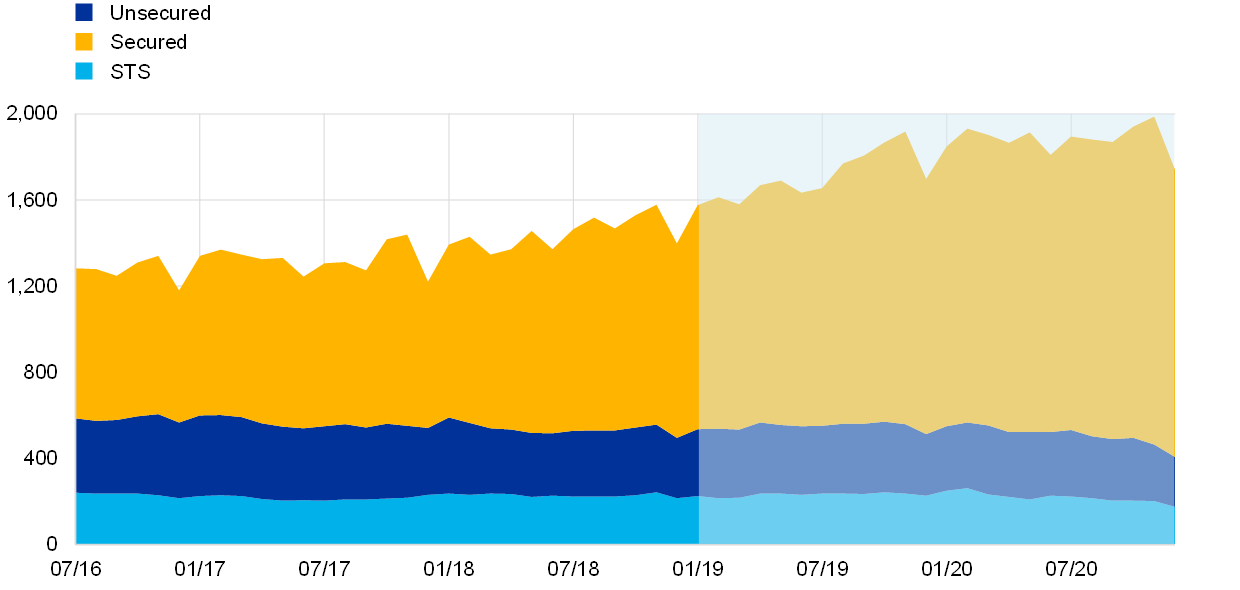
Sources: ECB (MMSR for Unsecured and Secured data), CSDB for STS data.
Note: “Unsecured” represents only the outstanding amount borrowed by MMSR banks excluding any short-term debt instruments. STS data refer only to euro area bank issuers. Only in EUR currency. Tenors up to one year. The chart shows outstanding amounts on the last day of each month.
In order to conduct a refined analysis of recent developments in the STS segment for all issuer sectors, the focus is on STEP and French NEU CP market issuance data. The STEP initiative has helped to promote the integration of short-term debt securities markets. Since 2006 this label, covering paper with a tenor of up to one year, has guaranteed compliance with a set of high standards and practices, including the provision of accurate and complete data in prospectuses. Furthermore, the short-term segment of the French STS market includes both commercial paper (NEU CPs) and medium-term notes (NEU MTNs). The depth and liquidity of the French market are based on its high level of transparency and openness to international issuers, especially since the 2016 reform. At the end of 2020, 58 NEU CP programmes (out of 397) carried the STEP label, representing 58% of the total amount. By the end of 2018, NEU CP issuances accounted for 45% of outstanding STEP papers.
With regard to currencies, a large share of STEP and NEU CP issuances are denominated in euro, followed by US dollars and pounds sterling (see Chart 3.3). At the end of 2020, euro-denominated issuances represented 62% of total STEP outstanding paper and 84% of NEU CP issuances. The higher proportion of non-euro issuances in STEP data is due to the presence of paper issued in London through the euro commercial paper programme, while NEU CP focuses only on issuances in Paris, which are largely euro-denominated.
During 2019 and for the first months of 2020, the euro-denominated segment for STS remained relatively stable. The euro-denominated outstanding amount was steady at around €400 billion.
Chart 3.3
STS outstanding amount by currency
(left-hand side: EUR billions; right-hand side: percentages)

Source: CSDB.
At the start of the pandemic in March 2020, banks’ STS issuances declined while issuances by public entities and corporates increased. The decline in outstanding amounts until March 2020 was driven by banks’ buybacks of STS in the asset portfolios of MMFs combined with a temporary but steady decline in new STS issuances. Meanwhile, during the second quarter of 2020, issuances from public entities surged to enable these bodies to cover their increasing funding needs. Similarly, issuances by NFCs also increased when some of them were made eligible for purchases by the Eurosystem under the PEPP.
Table 3.1
Cumulative net CP purchases under the PEPP in 2020‑21
(EUR millions)

Sources: ECB.
Notes: CP holdings are recorded as end-of-period book value at amortised cost. Net purchases are reported for the specified period at book value. The quarter-end amortisation adjustment and redemptions are not shown. Only CPs issued by non-financial corporations are eligible under the PEPP.
In the second half of 2020, STS outstanding amounts remained on a declining trend for all sectors. This dynamic may be explained by the normalising liquidity in this market and the declining funding needs of banks, due to the very attractive conditions of the alternative financing provided by the Eurosystem, as well as other issuers, since the problems the latter were required to address were gradually diminishing.
The relationship between excess liquidity and volume
The gradual decline in STS issuances by banks in the second half of 2020 coincided with rising levels of excess liquidity in the euro area (see Chart 3.4). This reflected the negative correlation between both variables, as banks’ increasing reliance on Eurosystem long-term funding represented, for them, an alternative source of financing to commercial paper issuance in the STS market.
Chart 3.4
Correlation between outstanding amount of bank NEU CP and excess liquidity
(y-axis: EUR billions; x-axis: EUR trillions)

Sources: Banque de France (NEU CP data) and ECB.
Notes: Vertical axis: outstanding amount of NEU CP issued by A1‑rated Financials (i.e. banks) for three-month, six-month and 12‑month tenors, only in EUR currency; horizontal axis: excess liquidity in the euro area. The pre-pandemic period refers to dates between 15 June 2017 and 31 December 2018. The pandemic period refers to dates between 13 March 2020 and 31 December 2020.
3.2 Rates – yields in the primary market
2019‑20 trends
Prior to 2020, yields were relatively stable – close to the DFR. In the shorter end, STEP yields on zero-coupon paper with zero to seven days maturity were, on average, 4 basis points below the DFR until the DFR cut in September 2019. From then on, the spread versus the DFR narrowed further to 3 basis points. With regard to longer tenors, in 2019 yields of up to six months were around 5 basis points above the DFR prior to the aforementioned rate cut and close to 10 basis points above the DFR after the rate cut, showing only a partial pass through for this tenor.
At the start of the COVID‑19 pandemic in early 2020, yields in both the shorter and the longer end temporarily increased as investors demanded a higher liquidity risk premium for STS (see Chart 3.5). From March to April 2020, STEP yields on short maturities of up to one week temporarily increased to ‑17 basis points, before returning to pre-pandemic levels over the following months, albeit with somewhat higher volatility. Longer tenors of up to six months followed a similar trend, both with regard to the size of the peak and the period of volatility that followed it, although with two minor differences. Compared with the shorter tenors, the reversal of tensions took longer for STS with six-month tenors and volatility after the April peak was more intense. However, once the declining trend shown by the longer tenors had started, it did not stop at pre-pandemic levels but fell even further.
In the second half of 2020, both shorter and longer tenors stabilised, to some extent, below the DFR. Shorter tenors decreased to 11 basis points below the DFR in July and then stabilised, trading on average at around 6 basis points below the DFR during most of the second half of 2020. Longer tenors of up to six months stabilised later – in the fourth quarter of 2020 they traded, on average, 3 basis points below the DFR.
Chart 3.5
STEP yield on zero-coupon paper by maturity
(percentages)

Sources: ECB (STEP database) and ECB calculations.
Notes: Average yield on zero-coupon STEP paper with a maturity of 0‑7 days and 92‑183 days respectively. Includes only papers with the highest credit rating. The period under review is indicated by a light blue background.
The spread between the 12‑month NEU CP yield and the corresponding OIS rate exhibited a temporary increase of up to 41 basis points during the pandemic (see Chart 3.6). Between March and May 2020, the spread temporarily increased from 20 basis points to 41 basis points. After that it gradually narrowed to 2 basis points in December 2020, a level well below the pre-pandemic spread. On the basis of these developments, market intelligence suggests that during the COVID‑19 crisis, in the second quarter of 2020, MMFs found it difficult to liquidate some of their STS holdings to satisfy large outflows of unit holders. The liquidity stress in the STS secondary market resulted in higher yields, reflecting the higher liquidity risk. Yields gradually declined when the Eurosystem’s new funding operations eased liquidity conditions in the money markets. Consequently, the lower demand for STS funding due to the excess liquidity arising from Eurosystem operations caused six-month (and longer) STS rates to remain at levels which were lower at the end of 2020 than they had been at the end of 2019.
Chart 3.6
Yield on 12‑month maturity OIS and NEU CP issued by A1 rated banks
(percentages)

Sources: Banque de France (NEU CP data) and Bloomberg.
Notes: Average weekly yield on 12‑month maturity commercial paper for A1‑rated bank issuers. The period under review is indicated by a light blue background. EURIBOR 12‑month plotted for comparison.
The relationship between excess liquidity and rates
Eurosystem liquidity injections during the COVID‑19 crisis have coincided with downward pressure on STS rates issued by banks (see Chart 3.7). The increase in excess reserves during the pandemic correlated negatively with the NEU CP rate issued by banks.
Chart 3.7
Correlation between rates of bank NEU CP and excess liquidity
(y-axis: percentages; x-axis: EUR trillions)

Sources: Banque de France (NEU CP data) and ECB.
Note: The vertical axis represents the volume-weighted average rate of NEU CP issued by A1‑rated financials (i.e. banks) for three-month, six-month and 12‑month tenors; only in EUR currency. The horizontal access represents the excess liquidity in the euro area. The pre-pandemic period refers to dates between 15 June 2017 and 31 December 2018. The pandemic period refers to dates between 13 March 2020 and 31 December 2020.
Yield curve
The STEP yield curve is flatter than it was two years ago (see Chart 3.8). In 2020, the curve steepened from March to May during the COVID‑19 crisis, before shifting downwards. By the year-end, the curve was flatter than it had been at the end of 2018, given the Eurosystem’s response to the COVID‑19 crisis.
Chart 3.8
STEP yield curve
(left-hand side: percentages; right-hand side: EUR billions; x-axis: maturity in days)
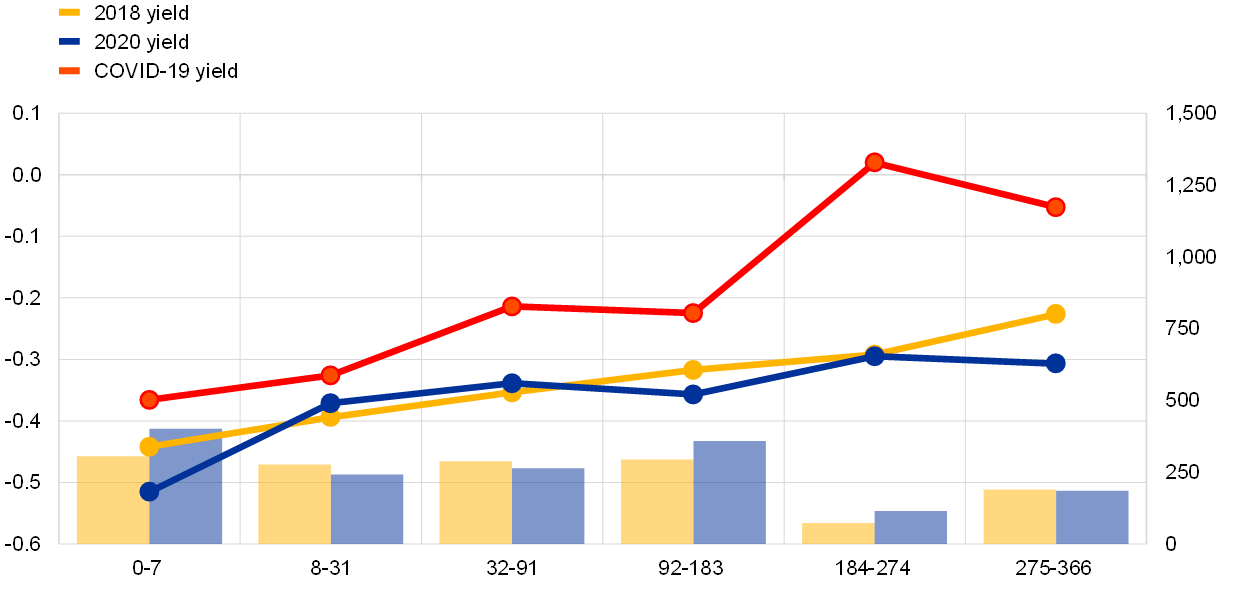
Sources: ECB (STEP database) and ECB analysis.
Notes: Average yield on zero-coupon STEP paper with tenors up until one-year and the highest credit rating A1. All currencies are included. The COVID‑19 yield refers to the period between 17 April 2020 and 1 May 2020.
3.3 Maturities
Outstanding volume per maturity
The maturity of the STS segment is more diversified than it is for other segments of the money market, (see Chart 3.9 and Chart 3.10). There is a wide distribution of issuances over the different maturity buckets, with tenors up to one-week, three-months and six-months representing 33%,16% and 23% of total issuance respectively.
Chart 3.9
STEP quarterly issuance volume by maturity
(EUR billions)

Source: ECB (STEP database).
Notes: All currencies. Volumes are per quarter. The period under review is indicated by a light blue background.
Chart 3.10
NEU CP quarterly issuance volume by maturity
(EUR billions)
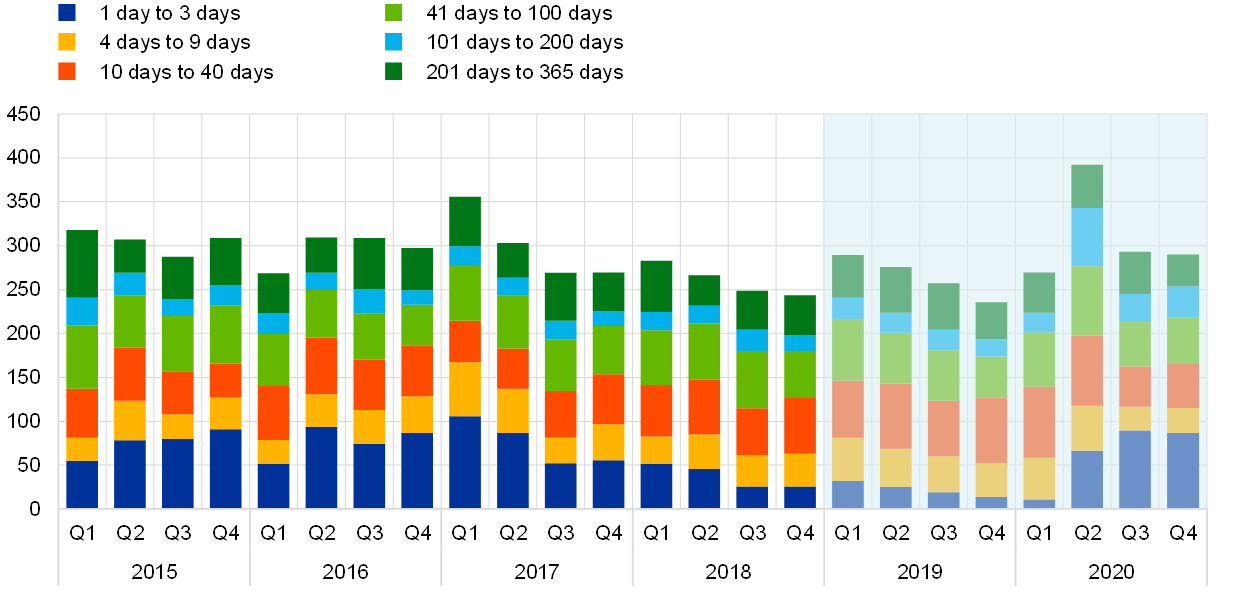
Source: Banque de France (NEU CP).
Notes: All currencies. Volumes are per quarter. The period under review is indicated by a light blue background.
Banks usually favour issuances on longer tenors while corporates and public entities refinance themselves on shorter maturities (see Chart 3.11). This dynamic is influenced by the LCR regulation which computes banks’ issuances only for tenors longer than one month. As non-bank issuers are not subject to the LCR regulation, they have a greater appetite for shorter tenors.
Chart 3.11
STEP outstanding amount at 31 December 2020 by maturity
(EUR billions)

Source: ECB (STEP database).
Note: All currencies.
During the COVID‑19 crisis banks temporary shortened maturities at issuance while public entities and corporate issuers moved issuances to longer tenors (see Chart 3.12). For the end of March, April and May 2020, NEU CP data reveal that the average initial maturity of monetary financial institution (MFI) issuances declined, partly because of higher overnight issuance volumes and partly because of greater issuing difficulties at longer tenors. This was also intertwined with the liquidity stress of MMFs at the start of the COVID‑19 crisis. However, the commercial paper purchases conducted by the Eurosystem under the PEPP have likely contributed to an easing of the funding conditions for non-bank issuers in this market. In contrast to banks, the average maturity of issuances by corporates increased over the same period, while public entities also increased their average maturity at issuance.
The shortening of maturities at the start of the COVID‑19 crisis had been partly reversed by June 2020. Notably, the average maturity of issuances from banks lengthened to almost 100 days, suggesting more normal market conditions.
Chart 3.12
Initial maturity of NEU CP monthly issuances by user
(maturity in days)

Source: Banque de France.
Notes: The initial maturity of NEU CP monthly issuances by category of user is measured in days and weighted by amount. All currencies.
3.4 Counterparties – investors and issuers
Flows by sector
The main issuers of STS in the primary market are banks, public entities and NFCs, while the investor base consists mostly of MMFs, insurance corporations and pension funds (see Chart 3.13). Meanwhile, in the secondary market some issuers may also buy back previously issued STS paper and investors may trade their holdings of certain instruments (such as commercial paper and certificates of deposit) in the short-term unsecured money market.
Chart 3.13
Counterparty sector flows in the STS primary market
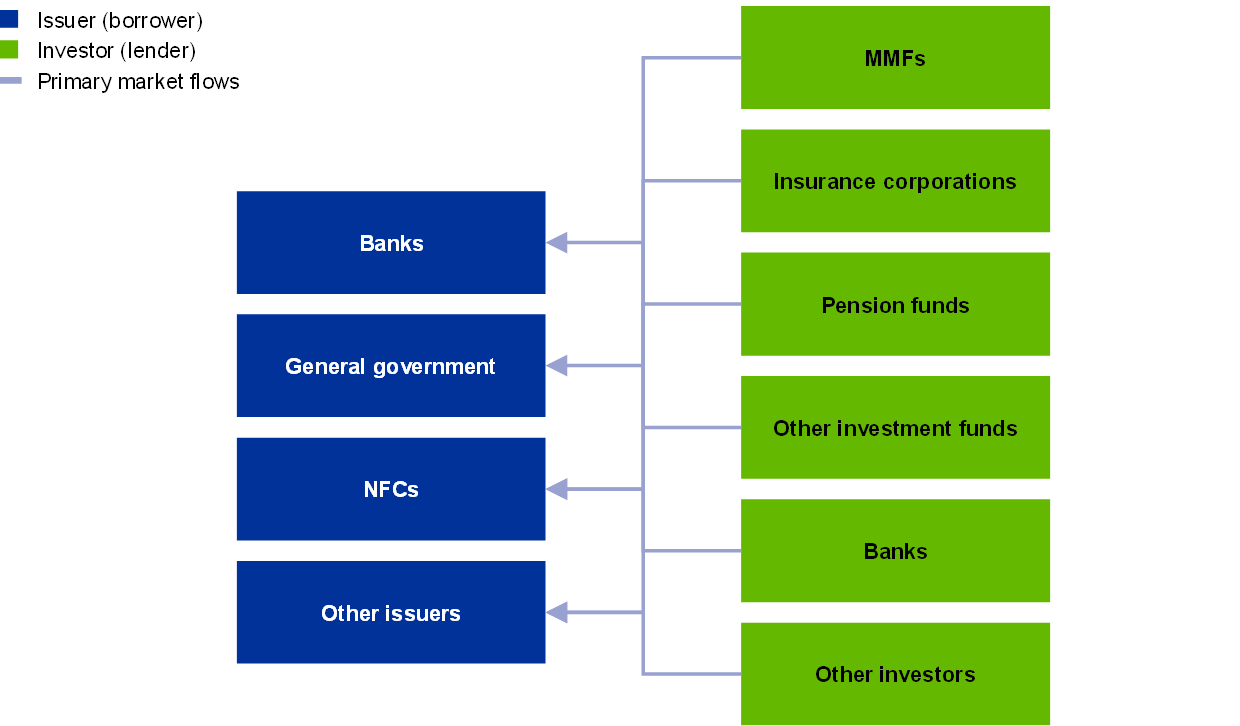
Source: ECB.
Notes: The selected counterparty sectors for investors are based on the largest issuers in the NEU CP and STEP data while for issuers they are based on the largest holders of short-term debt money market securities according to the CSDB.
Borrowers (issuers)
The banking sector is the main borrower in STS markets, despite its gradually decreasing share of outstanding amounts since the second quarter of 2020 (see Chart 3.14 and Chart 3.15). By the end of 2020, the banking sector represented 71% and 59% of total outstanding amounts in the STEP and the NEU CP markets respectively. In the NEU CP market there was a decline in the outstanding amount of paper issued by banks as of the second quarter of 2020 given that banks’ funding needs were largely covered by Eurosystem funding.
Prior to the second quarter of 2020, the outstanding amount of STS issued by banks remained fairly stable, except for a temporary increase during the third quarter of 2019. The Eurosystem’s introduction of the two-tier system resulted in several banks looking for additional funding in the STS markets to fully utilise their unused two-tier system allowance.
The outstanding amounts borrowed by public entities and NFCs have reached slightly higher levels since the second quarter of 2020. While public issuers represent over 14% of the commercial paper market, according to the STEP and the NEU CP data, NFCs represent around 25% of the NEU CP market but only 7% of the STEP market. The increase in the amount of funding raised by these sectors is driven by the higher overall funding needs public entities and NFCs have experienced during the COVID‑19 crisis.
Chart 3.14
STEP outstanding amount by issuer sector
(EUR billions)
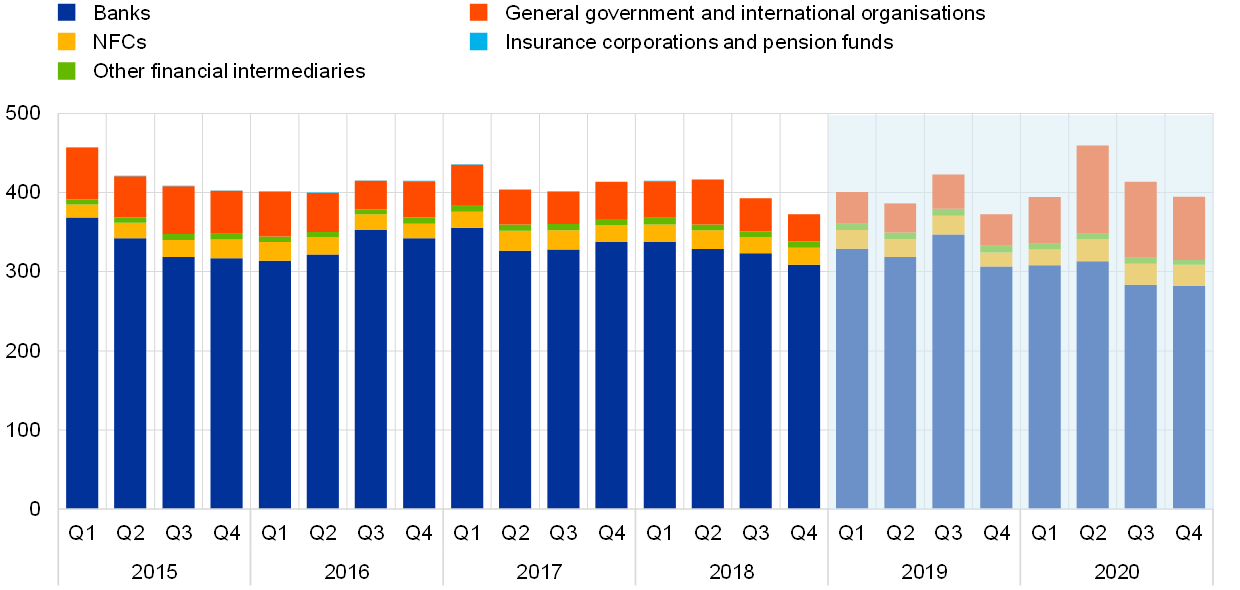
Source: ECB.
Notes: Average outstanding amount per quarter. The period under review is indicated by a light blue background.
Chart 3.15
NEU CP outstanding amount by issuer sector
(EUR billions)

Source: ECB.
Notes: Average outstanding amount per quarter. The period under review is indicated by a light blue background.
Lenders (investors)
MMFs are the largest lenders in the STS market, acquiring paper issued by MFIs and NFCs (see Chart 3.16 and Chart 3.17). Euro area MMFs traditionally provide short-term funding to banks and NFCs by investing in unsecured instruments such as commercial paper and certificates of deposit.
Prior to 2020, MMFs’ dominance increased every quarter. MMFs’ lending in the STS market, which grew between the first and the third quarters of 2019, emerged as a viable alternative to negatively remunerated deposits, especially for large and medium-sized corporate clients. This partly coincided with rising expectations of interest rate cuts during the second half of 2019, which in fact materialised in a DFR cut in September. In the last quarter of each calendar year, MMFs’ holdings of STS issued by NFCs generally exhibit a cyclical pattern, with the amounts outstanding repeatedly declining at the end of each year. In the first quarter of 2020, the amount of funding provided by MMFs to euro area non-financials via the short-term debt market increased by 18% (€7 billion) to €47 billion.
However, the role played by MMFs in the funding of euro area banks diminished between the end of 2019 and the end of March 2020. The amount of short-term debt issued by euro area banks held by euro area MMFs fell by 21% (€57 billion) to €197 billion between 31 December 2019 and 31 March 2020. The declining role of MMFs in the funding of banks was partially caused by the needs of these funds to liquidate some of their short-term debt (including through buybacks of commercial paper) in order to address the outflows observed at the start of the COVID‑19 crisis. According to BSI monthly data[15] MMFs’ AuM declined by around €40 billion in February 2020 (2% of their total AuM) to €1,251 billion. Euro area MMFs then saw inflows of assets in the subsequent months which more than offset the initial decline at the start of the COVID‑19 crisis. These inflows reached around €1,401 billion in AuM by the end of November 2020. By the end of 2020, MMF investors represented 67% and 54% of the short-term debt issued by banks and NFCs respectively.
The second-largest lender in the short-term debt market is the banking sector. The banking sector represents just above 11% of the total share of short-term debt outstanding issued by banks and non-financials at the end of 2020.
Chart 3.16
Outstanding amount of euro area banks’ STS by investor sector
(EUR billions)

Source: ECB (Securities holdings statistics database – SHS).
Note: Short-term debt includes commercial paper, certificates of deposits and other money market securities. MFIs include banks and central banks. The chart shows the outstanding amounts on the last day of each quarter.
Chart 3.17
Outstanding amount of euro area non-financials’ STS by investor sector
(EUR billions)

Source: ECB (Securities holdings statistics database – SHS).
Note: Short-term debt includes commercial paper, certificates of deposits and other money market securities. MFIs include banks and central banks. The chart shows the outstanding amounts on the last day of each quarter.
Flows by jurisdiction
Banks located in France, the Netherlands and Germany are the main issuers of STS, whereas investors are resident mainly in France, the Netherlands and the United Kingdom (see Chart 3.18).
Chart 3.18
Counterparty location flows for STS

Source: ECB, (MMSR).
Notes: The counterparty locations represent the top three largest borrower and lender locations in the commercial paper and the certificate of deposits markets, according to MMSR data.
Borrowers (issuers)
French banks are the largest borrowers, followed by Dutch and German banks (see Chart 3.19). During the COVID‑19 crisis, the amount of short-term debt issued by banks has declined in the three jurisdictions.
Chart 3.19
Outstanding amount of euro area banks’ STS by issuer location
(EUR billions)
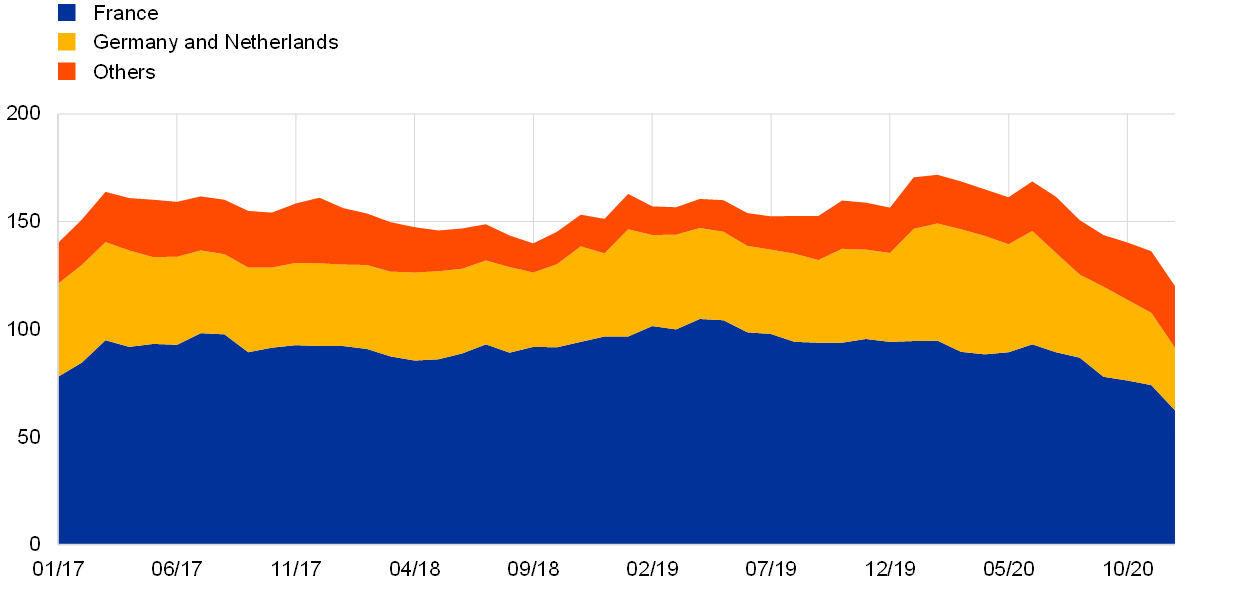
Source: ECB (MMSR).
Notes: Short-term debt instruments include commercial paper, certificates of deposits and floating rate notes, according to the MMSR nomenclature. Some countries were grouped for compliance with the applicable statistical confidentiality rules. Only borrowing transactions are included.
Lenders (investors)
French MMFs are the largest lenders to banks via the short-term debt market, with most of their holdings invested domestically (see Chart 3.20 and Chart 3.21). Investors in the Netherlands and the United Kingdom are other significant holders of STS issued by euro area banks. Although the AuM of euro area MMFs are largely located in Ireland and Luxembourg, these two jurisdictions do not seem to play a significant role in the funding of euro-denominated STS issued by banks. This finding likely reflects the greater overall concentration of AuM in other type of STS (i.e. those issued by NFCs or denominated in pounds sterling and US dollars) in Ireland and Luxembourg, as opposed to the euro-denominated STS issued by banks in AuM domiciled in France.
Chart 3.20
Outstanding amount of euro area banks’ STS by investor location
(EUR billions)

Source: ECB (MMSR).
Notes: Short-term debt instruments include commercial paper, certificates of deposit and floating rate notes, according to the MMSR nomenclature. Some countries were grouped for compliance with the applicable statistical confidentiality rules. Only borrowing transactions are included.
Chart 3.21
Assets under management of euro area MMFs
(EUR billions)
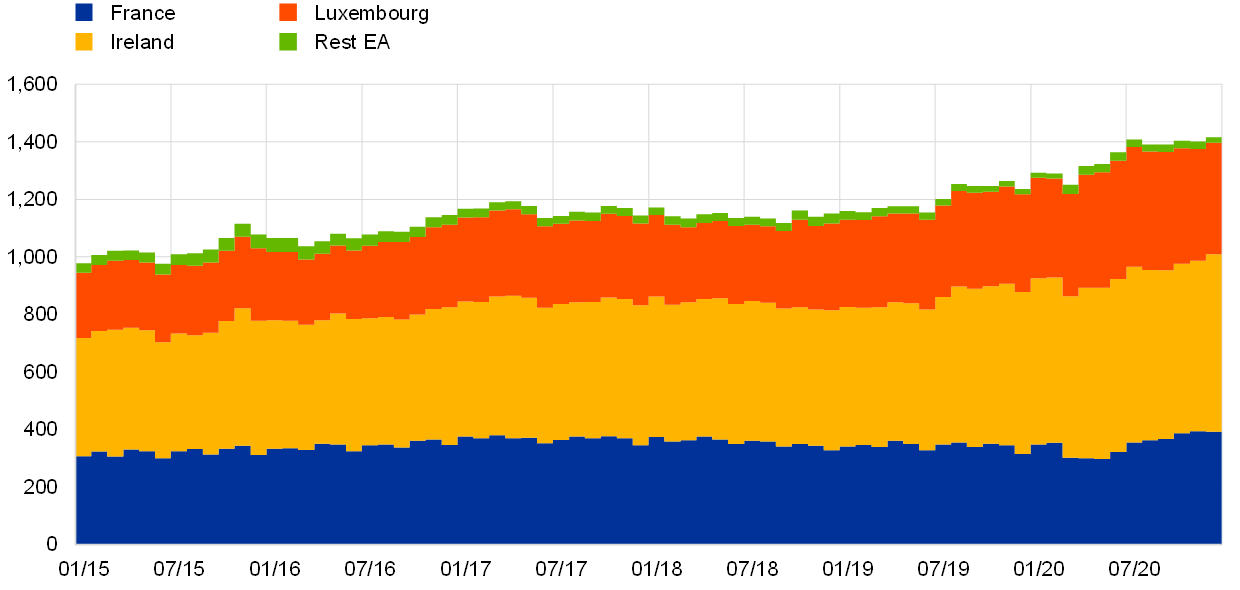
Source: ECB (Balance sheet items – BSI).
Notes: All currencies of denomination in euro equivalence. End-of-month figures by fund domicile.
4 The foreign exchange swap segment
FX swaps is the second-largest segment of the euro money market – it is the segment in which euro area banks obtain short-term US dollar funding and hedge assets against currency risk. The segment concentrates heavily on the US dollar for three reasons. First, this enables euro area banks to continue financing US dollar assets in euros while eliminating currency risk. Second, the US dollar is dominant in international trade and is in demand as a safe asset. Third, due to its high liquidity and fungibility, the US dollar also serves as an intermediary currency which can be used to obtain third currencies whose underlying FX swap market is less liquid against the euro.
Since regulatory reforms were introduced in the aftermath of the GFC, cross-currency basis swap rates have persistently violated covered interest rate parity. Moreover, changes in supply/demand equilibrium for US dollar funds and balance sheet supply constraints from US-based banks have made this segment vulnerable to sporadic shortages of US dollar liquidity among non-US financial institutions, despite the FX swap market being one of the most liquid in the world. Basis spreads fluctuated around 20 basis points for one-day maturities and 26 basis points for one-week maturities during the period under review.
Between January 2019 and December 2020, the segment was especially affected by two market shocks: (i) a short-lived liquidity squeeze in September 2019, when tensions in US repo markets spilled over into the FX swap segment and (ii) the COVID‑19 crisis, which prompted international investors to hoard US dollars in a flight-to-safety move that created shortages of US dollars at a global level. In autumn 2019, the turmoil in the US repo market was quickly transmitted to the FX swap market, pushing the one-day euro-dollar swap basis from 10 basis points in early September to a peak of 150 basis points. In the wake of the COVID‑19 crisis, the premium for borrowing US dollars against euro moved even higher than the 500 basis point threshold for one-day maturities. Subsequently, the Eurosystem’s US dollar operations have proved highly effective in alleviating these tensions, acting as a backstop to limit the cost of borrowing US dollars.
In addition to these unexpected shocks, pricing in this segment has also been affected around balance sheet reporting dates, when regulatory considerations have reduced the availability of US dollars in international markets. During the review period the tightening of US dollar funding conditions around reporting dates was less pronounced than it had been in 2017. Through prefunding, the FX swap segment may have found a new equilibrium where market participants are able to cope better with supply-demand imbalances arising from balance sheet restrictions.
4.1 Volumes
2019‑20 trends
FX swap transactions involve the borrowing and lending of foreign currencies, collateralised using domestic currency. An FX swap is an agreement between two counterparties to exchange one currency for another. The swap is closed at a later point in time by entering the opposite side of the transaction. The terms of closure, including the forward FX rate and the nominal amount, are pre-agreed by the parties when the transaction is executed, effectively removing FX risk. FX swaps are widely used by banks and other financial institutions in order to hedge foreign currency exposures, arbitrage the basis and/or close liquidity gaps in foreign currency holdings (i.e. manage deficits or surpluses of foreign currencies) on the balance sheet.
In the euro area, FX swap activity has grown notably over the last two decades (see Chart 4.1). FX swap activity stood at an average daily volume of €227 billion throughout 2020, double the 2005 amount. Outstanding amounts stood at €2.5 trillion in 2020. The increasing importance of FX swaps is partly attributable to changes in hedging activity. Euro area banks hold significant US dollar assets and FX swaps allow them to fund these assets by means of domestic liabilities, hedging the currency mismatch by swapping euro funds into equivalent foreign currency. According to data from the Bank for International Settlements, non-US entities hold about USD 14 trillion of US dollar assets, not all of which are funded by liabilities denominated in US dollars, such as deposits, loans and bond issuance. The world FX funding gap – estimated by the IMF to be about USD 1.5 trillion – needs to be closed by borrowing in domestic currencies and swapping these funds into US dollars. This implies that the euro area FX swap market appears to capture approximately 15% of the global funding gap for US dollars.
Chart 4.1
Market size per segment – average daily transaction volumes
(EUR billions)

Source: Panel (a) – ECB (euro money market survey) until 2016 and ECB (MMSR) from 2016 onwards; Panel (b) – ECB (MMSR).
Notes: Panel (a) includes only interbank counterparties and CCPs; Panel (b) includes all reported counterparties. The bars show euro money market survey data for 38 overlapping reporting agents and retropolated data for the 14 MMSR reporting agents not covered in the survey. The retropolation increases the original series by a fixed proportion representing the 14 missing reporting agents’ market share in Q3 2016 (2% for the FX swap segment). Two confidential datapoints have been interpolated. The OIS segment excludes novations in MMSR data.
The bulk of the FX swap activity conducted by euro area banks involves euro and US dollar trading (see Chart 4.2)[16]. EUR/USD swap transactions in 2020 represented 80% of overall volume traded, in line with the figures for 2018 and 2019. This share confirms the leading role played by the US dollar in FX swap activity, which can be attributed to three main factors. First, euro area banks continue to finance US dollar assets in euros while eliminating currency risk. Second, the US dollar is dominant in international trade and is recognised as a safe asset. Most international trade is invoiced in US dollars and this also applies to a large proportion of all cross-border loans and securities issued worldwide. Third, due to its high liquidity and fungibility, the US dollar also serves as an intermediary currency which can be used to obtain third currencies whose underlying FX swap market against the euro is less liquid. For instance, a bank which needs a specific FX may have an economic incentive to swap euro against US dollars and, subsequently, US dollars against FX as opposed to swapping euro against FX directly. The pound sterling accounts for the second-largest share of FX swaps, trading 8% of total volume – the other global currencies, including the Swiss franc and the Japanese yen, make up the remaining 12%.
Chart 4.2
Currency breakdown of FX swaps against the euro
(EUR billions)
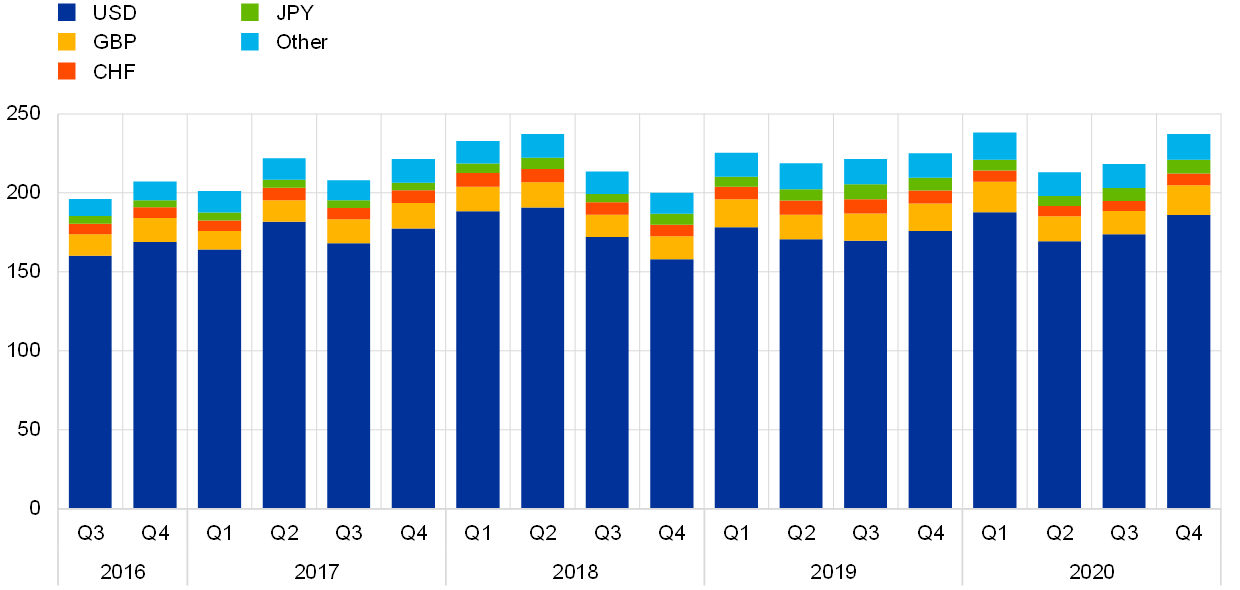
Source: ECB (MMSR).
Notes: Daily average transaction volumes per quarter.
Reliance on FX swaps over time had left this segment exposed to sporadic shortages of US dollars. The phenomenon of domestic cash hoarding prevented the segment from working smoothly when liquidity failed to reach foreign US borrowers via the FX swap market, causing severe demand/supply imbalances. Over the last two decades, turbulence in the FX swap markets has always initially been caused by a shortage of US dollar funding among non-US financial institutions. While these institutions tried to secure US dollars to fund their operations, US participants in the interbank market who had previously supplied the currency were hoarding more reserves than usual to support their own funding needs and because of their concerns over rising counterparty risk.
Over the review period, both stock and flow data remained stable, apart from during the COVID‑19 period (see Chart 4.3 and Chart 4.4). In March 2020, demand for US dollars far outstripped supply, and daily FX swap turnover increased to above €215 billion by mid-April, leading to a sudden increase in the premium on borrowing US dollars against the euro. A subsequent reactivation of central banks’ swap line network provided an alternative to market funding and injected USD 403 billion into non-US banks based in euro area, Switzerland, Canada, Japan and the United Kingdom by end-May 2020, mostly at a three-month maturity. Euro area banks drew USD 143.5 billion (or 36%) from that amount. As the central bank dollar supply flowed through banks’ balance sheets, FX swap reliance became less obvious, reducing the daily traded volume to below €130 billion. Recourse to central bank operations thus helped to alleviate tensions and activity slowly normalised in the FX swap segment, with less reliance on backstop swap lines.
Chart 4.3
Outstanding amount bought and sold by euro area banks
(EUR billions)

Sources: ECB (MMSR for” Unsecured” and “Secured” data), CSDB for STS data.
Notes: “Unsecured” represent the outstanding amount borrowed and lent by MMSR banks, excluding any short-term debt instruments. “Foreign exchange swap” represents buying and selling the EUR/USD currency pair. “STS” data refer to the outstanding amount issued or held by euro area banks, only EUR currency. Tenors up to one year. The stacked areas show the amounts outstanding on the last day of each month.
In addition, volumes often drop on US public holidays. Beyond the effect of large market shocks, turnover can also be affected when payment systems are closed in the United States because of national holidays. For instance, on President’s Day (around 15 February) and Memorial Day (at the end of May) euro area banks report that average volumes declined by a third[17].
Chart 4.4
Daily FX swap volume across time – ten-day moving average
(EUR billions)

Source: ECB (MMSR).
Notes: Smoothed by the ten-day moving average. Only transactions including the USD/EUR currency pair.
The relationship between reporting dates and volumes
Euro area banks actively prepare for FX swap tensions around reporting dates by means of prefunding (see Chart 4.5). Close to regulatory reporting dates, US banks, similarly to their European peers, reduce the size of their balance sheets in order to comply with prudential regulation. In 2017 euro area banks experienced a large increase in the premium on borrowing US dollars against euro covering the year-end period. As a result, in subsequent years banks have opted to prefund approximately 20% of their year-end needs months in advance, in anticipation of year-end borrowing premium spikes. A further 30% are borrowed at a few weeks’ notice, while around 50% of banks’ year-end needs are covered by borrowing in the few days preceding the turn of the year in one-day maturity trades.
Chart 4.5
US dollar prefunding volumes ahead of year-ends
(EUR billions)

Source: ECB (MMSR).
Notes: Includes FX swap trade volumes that settle 3 months before year end and mature within 1 month after year end. Only transactions selling EUR to buy USD are included. Plotted against TARGET2 business days. Confidential values are hidden. Cumulative volume.
4.2 Rates
2019‑20 trends
Non-US banks’ heavy reliance on the FX swap market meant that rates persistently deviated from covered interest rate parity. Basis spreads are currently fluctuating at an average of 20 basis points for one-day maturities and 26 basis points for one-week maturities, excluding quarter-ends since 2018. The basis spread between the US dollar and another currency is the premium paid by international institutions to obtain dollars in the FX swap market. This premium is measured as the difference between the average implied interest rate on US dollars borrowed in the EUR/USD FX swap market and the US dollar risk-free rate, which is represented by the US dollar OIS rate. The pricing of an FX swap (e.g. an EUR/USD FX swap with a maturity of three months) reflects the fact that a euro area investor has two options: (a) invest the money in the unsecured euro cash market for three months at the prevailing euro denominated interest rate or (b) convert the euro into US dollars through a three-month FX swap and invest the dollars for three months at the prevailing dollar-denominated interest rate, e.g. by purchasing and holding a three-month US Treasury bill. After three months the investor collects the final payout from the Treasury bill and concludes the FX swap by trading the dollars back into euro. In an efficient market these two strategies must provide equal returns once three months have elapsed, otherwise arbitrage will ensure that the less costly/higher return option is exploited until the two returns are equalised once again. In the absence of market frictions, the US dollar basis spread should hover around zero for the major, very liquid currencies. However, since the GFC, FX swap-implied US dollar funding rates significantly exceeded the dollar-denominated interest rate on several occasions, when demand for the US dollar far outstripped its supply, even against the major currencies.
Implied yields in the EUR/USD swap market follow US interest rate movements in the US dollar domestic funding markets under normal circumstances (see Chart 4.6). When markets are functioning well and intermediation is not impaired, implied yields stand very close to US domestic interest rates, compressing the FX swap basis spread. The US interest rate changes are rapidly reflected by a symmetrical movement in FX swap market implied rates, demonstrating market efficiency and liquidity. Accordingly, the observed decline in US dollar borrowing implied yields reflects the monetary policy decisions taken by the Federal Reserve System, which gradually cut policy interest rates between the July 2019 range of 2.25‑2.5% and the latest cut on 23 March 2020 to 0‑0.25%, which are captured by the movements in the effective federal funds rate.
Chart 4.6
US implied yield per maturity
(percentages)
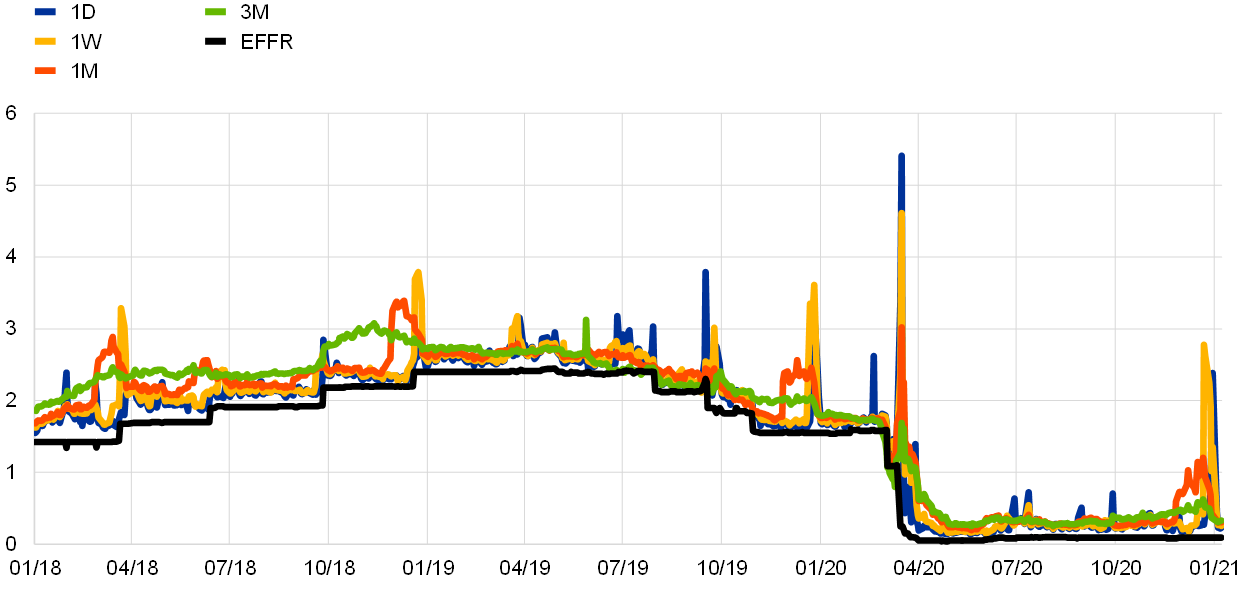
Source: ECB (MMSR), Bloomberg and ECB Calculations.
Notes: US implied yield is derived from the covered interest rate parity. One-day trades combine the O/N, S/N and T/N for a selected settlement day. Plotted against settlement date. EFFR stands for the effective federal funds rate (Bloomberg). Confidential and missing values hidden.
Nevertheless, when US dollar funding conditions tighten and intermediation becomes strained, implied yields start to increase and to diverge from comparable domestic US dollar borrowing rates (see Chart 4.7). During the period under review, the premium paid by euro area banks to borrow US dollars increased significantly on three occasions: (i) during the US domestic tax-related market stress in September 2019; (ii) ahead of the 2019 and 2020 year-ends and (iii) during the COVID‑19 crisis.
Chart 4.7
FX swap basis spread (USD implied borrowing yield – USD OIS)
(basis points)

Source: ECB (MMSR), Bloomberg and ECB calculations.
Notes: The FX swap basis spread is calculated as the USD implied rate minus the USD OIS rate for the selected maturity. The axis is cut off at 300 basis points in the interests of readability. One-day trades combine the O/N, S/N and T/N for a selected settlement day. Plotted against settlement date. Confidential and missing values hidden.
The September 2019 turmoil in US repo markets pushed the one-day euro-dollar swap basis up to nearly 150 basis points, with pressures also seen in one-week and one-month maturities. For a short period of time US repo rates soared to 6%, driven by the sudden withdrawal of liquidity from the US repo segment. The liquidity squeeze was triggered by an unexpected dip in the level of US dollar excess reserves, due to the combination of large corporate tax payments and a large US Treasury settlement. The markets were caught off guard – the spike was due to a general underestimation of the structural level of excess reserves required in the system. Because of the sudden draining of US dollar excess liquidity, US banks reacted to the relative shortage of US dollars in the domestic market by hoarding liquidity. They were also hesitant to lend to international counterparts, leading to a spillover to the FX swap market and the driving up of premia. The FX swap basis spread soared to 150 basis points, from the level usually observed of around 20‑30 basis points. After the Federal Reserve System intervened to ease domestic liquidity conditions, both US repo rates and the FX swap market stabilised.
The COVID‑19 crisis also increased demand for US dollar funding. The market stress during the pandemic and the generalised “dash for cash” caused a severe demand-supply imbalance in the FX swap segment, with borrowing premia in the one-day maturity rising above the 500 basis points threshold. The longer maturities also displayed symptoms of stress, although pricing was more contained with the premium for the three-month maturity staying at 147 basis points. The situation stabilised in April 2020, after the central bank swap line network enhanced US dollar provision.
The relationship between use of the Eurosystem’s US dollar swap line and rates
Since 2007 the Eurosystem has offered US dollar operations to euro area banks to alleviate pressures in short-term US dollar funding. As soon as US dollar funding strains became evident in the wake of the COVID‑19 outbreak, the provision of US dollars via central banks’ swap line network was reactivated[18]. The swap line network is an agreement between the largest central banks to bilaterally provide their respective currencies via FX swap transactions to avoid stress building up in domestic FX markets[19]. In recent years the swap lines have been activated a number of times to address elevated pressure in offshore US dollar short-term funding and to ease strains in global funding markets. Eurosystem US dollar operations have always been priced at a premium over the US dollar OIS rate for an equivalent maturity. Despite the lack of maximum bid limits in the operations, the pricing above the OIS rate effectively caps participation and ensures that the operation is used as a prudent backstop, rather than replacing market functioning.
As a part of coordinated central bank action aimed at enhancing the provision of global US dollar liquidity, the price of the swap line facility was lowered, a longer-term operation was added, and the frequency of the facility was increased. On 15 March 2020 the Eurosystem – together with the Federal Reserve System, the Bank of Canada, the Bank of England, the Bank of Japan and the Swiss National Bank – lowered the cost of US dollars provided in exchange for local currency collateral from OIS +50 basis points to OIS +25 basis points. In addition to the existing seven-day operation, a weekly 84‑day operation was added to increase the swap lines’ effectiveness in providing relief to the market. Subsequently, on 20 March the frequency of the seven-day operation was increased from weekly to daily.
The coordinated central bank actions successfully eased global US dollar funding strains (see Chart 4.8). The outstanding amount of US dollars borrowed via the swap network reached USD 403 billion, of which USD 144 billion were drawn by euro area banks. The coordinated US dollar liquidity provision brought significant relief to FX swap markets across multiple currency pairs in terms of both volumes and prices. As a result, the premium for borrowing US dollars against euro in the one-day maturity declined from USD OIS + 515 basis points (5.4%) at its peak to approximately USD OIS + 10 basis points (~0.15%) by the end of April 2020 as the pricing of US dollars provided via the swap network effectively capped market prices[20].
Chart 4.8
US dollar swap line usage per central bank and per maturity
(left-hand side: USD billions; right-hand side: percentages)

Source: ECB (MOPDB) and Bank of England (BOE), Swiss National Bank (SNB), Bank of Japan (BOJ) operations data.
Notes: The blue line indicates the share of participation in 84‑day operations as a percentage of total participation in the Eurosystem’s swap lines. The first observation is 17 March 2020 coinciding with the reactivation of central banks’ swap line network. Prior to this date the recourse to the swap line facility was concentrated around reporting dates.
As the market stabilised, US dollar demand from the central banks’ swap lines declined. Following normalisation in the FX swap market, the outstanding amounts borrowed from the central banks’ swap lines gradually decreased as the cost of funding US dollars via FX swaps eventually declined to a level below the price at which they were refinanced at the central banks. Consequently, the Eurosystem – and the other global central banks – gradually reduced the frequency of operations from daily to weekly[21].
The relationship between reporting dates and rates
The EUR/USD FX swap market exhibits a seasonal pattern ahead of reporting dates, especially at year-ends (see Chart 4.7 above). US banks are particularly keen to reduce their balance sheet size over reporting dates due to related regulatory and tax costs. As a consequence, they are less keen to intermediate between domestic lenders and foreign borrowers and prefer to hold excess reserves with the central bank. The resulting contraction of US dollar supply is then reflected in rising borrowing premia on US dollars. In 2019 and 2020, the FX swap basis widened to an average of 47 basis points around quarter-ends and to 140 basis points at year-ends, for one-day transactions. Therefore, unlike market shocks, the increase in the FX swap basis at key reporting dates follows a seasonal pattern, although it varies in magnitude as a function of the intermediation capabilities of large international banks.
The central bank swap line helps euro area banks to cover their year-end needs. There was a short-lived increase in participation in US dollar operations just before the end of the year. After a few months of favourable borrowing conditions compared with 2018 and 2019, the premium on borrowing US dollars against euro in tenors covering the 2020 year-end increased during December, largely reflecting reduced supply by large intermediators, as described above. Nevertheless, year-end funding premia remained broadly in line with those seen in 2018 and 2019 across all tenors, and below the peak levels reached in 2016 and 2017. US dollar demand only increased on 16 December, the last day for US dollar operations covering the year-end, when the US dollar tenders allotted USD 3.6 billion to 13 bidders (although this was the smallest year-end take-up since 2017). Demand was concentrated in the short-maturity operation which was, exceptionally, a 21‑day operation, so that funds could be repaid immediately after year-end, when funding conditions typically normalise. By contrast, during the early stages of the pandemic banks preferred the three-month operation. The longer maturity helped to alleviate uncertainty, so more than 90% of the outstanding amount was held in the three-month operation.
4.3 Maturities
Transaction volumes per maturity
FX swap transactions tend to be concentrated in short maturities, i.e. those up to one week (see Chart 4.9). The predominance of short-term transactions is attributable to the fact that a large part of FX swap transactions are conducted for balance sheet fine-tuning purposes on a short-term basis. Participants use the FX swap segment to move a specific currency temporarily in or out of their balance sheets, without incurring the exchange rate risk associated with maintaining an open position in the currency they are temporarily holding. About one-third of FX transactions have a non-standard, customised tenor as FX swap contracts are traded over-the-counter and counterparties can therefore agree on the bespoke characteristics of the transaction, including the maturity. Forward-dated contracts only represent about 5% of total FX swap volumes.
Chart 4.9
Average daily volumes by maturity
(EUR billions)

Source: ECB (MMSR).
Notes: All currencies.
In periods of stress the distribution bias towards shorter tenors is exacerbated (see Chart 4.10). During the September 2019 and the pandemic crises, the generalised “dash for cash” led to a marked increase in one-day transaction volumes.
Chart 4.10
FX swap USD sell volumes by maturity
(EUR billions)

Source: ECB (MMSR).
Notes: Only transactions selling US dollars are included. Confidential values are hidden. Smoothed by the five-day moving average. The periods of September 2019 and the peak of COVID-19 market tensions are indicated by a light blue background.
Outstanding volumes per maturity
Despite the low daily trading in longer tenors, a significant part of outstanding FX contracts has an initial maturity of about three months (See Chart 4.11). Maturities of between one week and three months account for 52% of the total outstanding volume of the segment. The volume-weighted average maturity of the market has fallen after the outbreak of COVID‑19 period from 24 days to 21 days at the end of review period.
Chart 4.11
Share of tenors in the total FX swap outstanding amount by maturity
(percentages)

Source: ECB (MMSR), ECB calculations.
Notes: The outstanding amount is a snapshot taken at 15 September 2020 in order to avoid reporting dates. The outstanding amount transforms the daily transaction volumes (flows) into a stock variable based on maturity dates. Only EUR/USD currency pair.
4.4 Counterparties
Flows by sector
Banks make up most of the turnover in the FX swap market (see Chart 4.12). More than 90% of transactions, in terms of volume, are conducted between banks, whose large share is explained by their intermediation role. The second group in terms of importance are other financial corporations, which include, among others, MMFs, pension funds and insurance companies.
Intermediating banks typically run a matched book (see Chart 4.13). This is accomplished by hedging, directly or synthetically, any position arising from servicing client needs. Direct hedging is achieved by matching every client transaction with a transaction of equal amount and tenor but opposing sign, either with another client or in the interbank market. Synthetic hedging is achieved by matching a client transaction with a combination of different transactions to eliminate currency and duration risk. This is achieved, for instance, when a FX forward sale is synthetically hedged with a FX spot purchase and a FX swap between the spot date and the FX forward settlement date.
Chart 4.12
FX swap volume by counterparty sector
(EUR billions)

Source: ECB (MMSR).
Notes: The chart shows buy and sell transactions. All currencies are included.
Chart 4.13
Daily FX swap volume by transaction type
(EUR billions)

Source: ECB (MMSR).
Notes: Daily average transaction volumes split by transaction side plotted against trade date. Smoothed by the ten-day moving average. Only USD/EUR currency pair.
Flows by jurisdiction
Large banks channel net US dollar resources from international financial centres to euro area clients (see Chart 4.14 and Chart 4.15). When focusing on EUR/USD FX swaps euro area banks tend to maintain a matched book structure, resulting in a net US dollar position which is small compared with the notional outstanding of the FX swaps. Euro area banks seem to use FX swaps to intermediate between counterparties located in the US and those in the UK, who are natural providers of US dollars, and euro area clients in need of US dollars. Euro area clients come predominantly from the financial sector (non-banks) and benefit from the international connections of euro area intermediating banks. More granular data confirm that most financial counterparties located in Luxembourg and the Netherlands, which are net recipients of US dollar funding, are pension funds and investment funds.
Chart 4.14
Net position of EUR/USD FX swaps by counterparty location
(EUR billions)

Source: ECB (MMSR).
Notes: The net position is calculated as the difference between total buy volume and total sell volume, settled between 1 January 2019 and 31 December 2020 and maturated after 31 December 2020. A positive figure means a borrowing position. The net position is broken down by counterparty jurisdiction. The green columns show the trades of MMSR banks recorded with international counterparties while the blue columns show the trades within the euro area. Includes only USD/EUR transaction pairs. Countries: US – United States, GB – United Kingdom, JP – Japan, CA – Canada, AU – Australia, CH – Switzerland, ES – Spain, DE – Germany, FR – France, IE – Ireland, FI – Finland, IT – Italy, LU – Luxembourg, NL – the Netherlands, Other EA – all remaining euro area countries, Other – all remaining countries.
Chart 4.15
Net position of EUR/USD FX swaps by counterparty sector and location
(EUR billions)
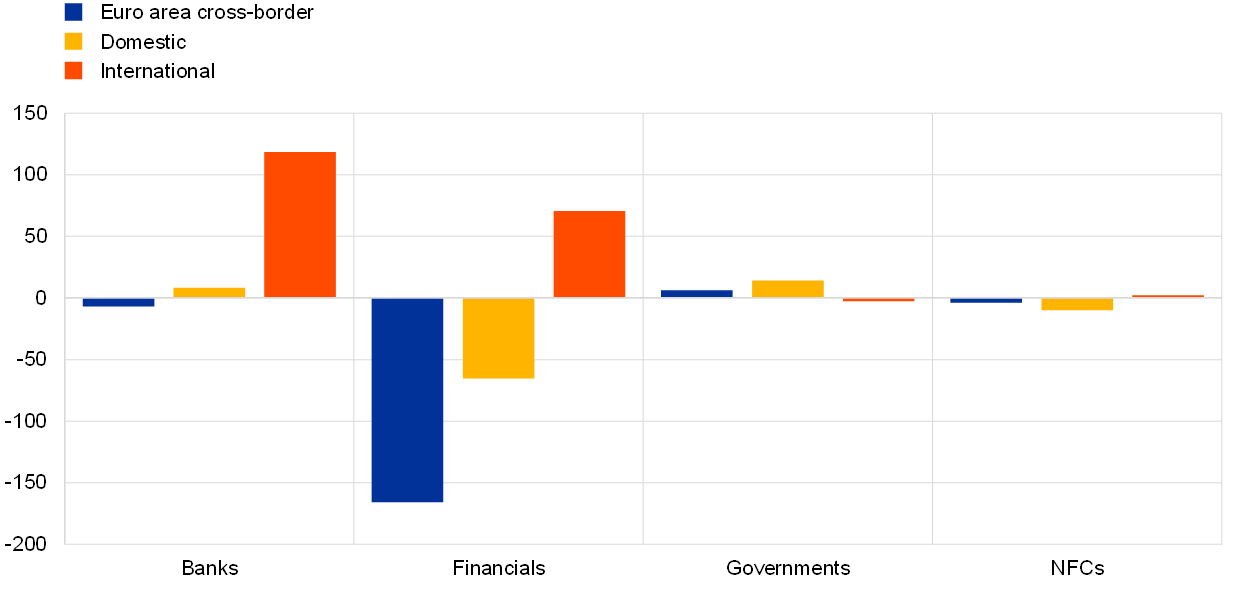
Source: ECB (MMSR).
Notes: Net position is calculated as the difference between total buy volume and total sell volume, settled between 1 January 2019 and 31 December.2020 and maturated after 31 December 2020. The net position is broken down by counterparty sector and location. The red columns capture the trades of MMSR banks recorded with international counterparties, the blue columns show cross-border trades within the euro area, and the yellow columns show the transactions with domestic counterparties. Includes only USD/EUR transaction pairs.
5 Overnight index swaps
The OIS segment is the only money market segment that cannot be used for market funding as it consists of derivatives without exchange of notional amounts. Unlike the other segments, OIS cannot be used to borrow or lend cash. The OIS market allows counterparties to hedge interest risk or speculate on the future path of overnight interest rates. Central bankers and analysts can use OIS rates as a measure of the market’s expectations of the future trajectory of overnight rates, which are often driven by changes to official policy rates.
Over the last two years volume in the OIS segment have been low compared with the period before the GFC. As the Eurosystem’s monetary policy measures have anchored rate expectations at negative levels for a prolonged period of time, the market’s interest rate hedging needs have been less significant. However, activity in the OIS segment has been stimulated ahead of Governing Council meetings when the markets anticipated further monetary policy easing measures.
OIS rates decreased sharply in the third quarter of 2019 in anticipation of the September DFR cut. After some stabilisation, rates declined again in the first quarter of 2020 in expectation of a significant response from the Eurosystem to the COVID‑19 crisis. Since then, OIS rates have remained relatively stable, reflecting expectations that overnight rates are likely to remain low and that excess liquidity is expected to remain high for many years to come.
From a maturity perspective, transaction volume in the OIS market is highly concentrated around the three-month maturity bucket. While the average maturity profile of new trades is below one year, most risk-taking activity is clustered around outstanding contracts with a maturity longer than one year.
Almost all OIS trades are cleared through CCPs. Over the review period, there was a slight shift in trading away from LCH Ltd to EUREX, which is based in the euro area. This shift coincided with some uncertainty with regard to future clearing arrangements following the UK’s withdrawal from the EU.
A structural change in the OIS segment has been the transition of contracts from EONIA to the new €STR benchmark. This process started with the publication of the €STR in October 2019 and is expected to continue until January 2022, when EONIA will be discontinued. At the end of 2020, a large share of OIS outstanding contracts still referred to EONIA, so fallback arrangements need to be made to continue servicing EONIA-based contracts after its discontinuation[22].
5.1 Volumes
2019‑20 trends
OIS contracts are used to manage interest rate risk and can be used to infer market expectations of the path of interest rates. OIS are one of four major categories of interest rate derivatives, alongside interest rate swaps (IRS), forward rate agreements (FRAs) and basis swaps. OIS contracts help banks and other market participants to hedge against unexpected changes in overnight interest rate levels. Firms also use them to speculate on the path of the overnight market rates. In an OIS agreement, one party exchanges a fixed payment over a nominal amount and receives a floating rate (i.e. €STR) payment from the other party for each day of the contract duration. OIS are also of interest to central banks as their prices track market expectations with regard to interest rate changes. For example, the fixed rate for a one-year OIS indicates the market’s expectations for overnight interest rates over the next year.
Table 5.1
Overview of key over the counter interest rate derivative products in EUR

Sources: CME, LCH, EUREX.
Notes: Figures used are notional outstanding as of 31 December 20. Zero coupon and variable notion swaps account for the remaining 1% of market share. Clearing house data include both sides of the transaction in the outstanding amount.
The average daily volume of OIS transactions amounted to €47 billion in the period 2019‑20 (see Chart 5.1). Since 2012, volumes in the OIS segment have remained stable, albeit at relatively lower levels compared with volumes prior to the GFC, excluding novations[23]. OIS volumes were little changed over the review period, which was consistent with a protracted period of small changes in Eurosystem policy rates and continued forward guidance. As the Eurosystem’s monetary policy easing underpinned market interest rates and volatility was low, the need for OIS trading declined.
Chart 5.1
Market size per segment – average daily transaction volumes
(EUR billions)
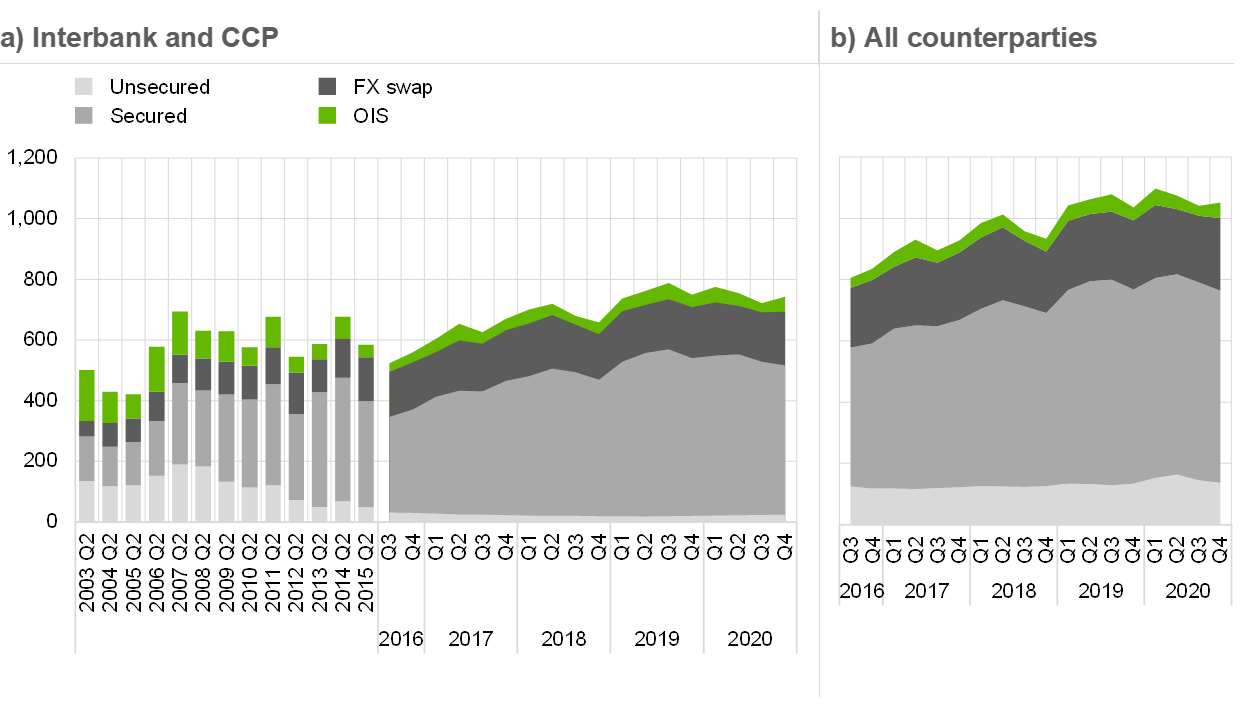
Sources: Panel (a) – ECB (euro money market survey) until 2016 and ECB (MMSR) from 2016 onwards; Panel (b) – ECB (MMSR).
Notes: Panel (a) includes only interbank counterparties and CCPs; Panel (b) includes all reported counterparties. The bars show euro money market survey data for 38 overlapping reporting agents and retropolated data for the 14 MMSR reporting agents not covered in the survey. The retropolation increases the original series by a fixed proportion representing the 14 missing reporting agents’ market share in Q3 2016 (4% for the OIS segment). Two confidential datapoints have been interpolated. The OIS segment excludes novations in MMSR data.
Volumes in the OIS segment increase whenever markets anticipate changes to the Eurosystem’s monetary policy, particularly in respect of policy rate changes (see Chart 5.2). This is because the Eurosystem’s monetary policy is the major determinant of overnight rates, which form the basis of OIS rates. During the review period, OIS trading volumes increased ahead of Governing Council meetings when either interest rate cuts or significant easing measures were expected. In 2019, average trading volumes doubled ahead of the June and July meetings when the market speculated over the possible introduction of a two-tier system for remunerating banks’ reserve holdings. The two-tier system was perceived to be a measure which mitigated one of the detrimental effects of the negative interest rate policy, ensuring the reversal rate (the rate at which adverse effects of policy rate cuts exceed benefits) was not reached. As such, the market perceived that the two-tier system measure under consideration meant that further rate cuts were also under deliberation. The increase in volumes continued ahead of the September 2019 Governing Council meeting, in anticipation of a DFR cut. In 2020, OIS activity was greatest ahead of the March Governing Council meeting when an interest rate cut as additional response to the COVID‑19 crisis was expected. OIS activity had also increased by the end of 2020, when markets priced in a significant recalibration of easing measures by the Eurosystem.
Chart 5.2
OIS transaction volumes by trade date – ten-day moving average
(EUR billions)

Sources: ECB (MMSR) and ECB calculations.
Notes: OIS paid and received transaction volume plotted against trade date. Smoothed by the ten-day moving average. Excluding novations and including all maturities. The blue squares indicate the ECB Governing Council monetary policy meetings in 2020 and the yellow diamonds indicate the 2019 meetings.
During the review period, spot transactions volumes remained greater than forward transaction volumes and banks kept a balanced net trading position (see Chart 5.3 and Chart 5.4). OIS transactions with spot settlement tend to be used by different market actors from those with forward settlement. The former are used mostly by asset and liability managers aiming to hedge their portfolios while the latter are used more by hedge funds to take a betting position on central bank interest rate movements. Accordingly, speculative forward starting OIS volumes are more volatile than spot OIS volumes which are primarily used for hedging purposes. Forward contracts coinciding with the central bank’s minimum reserve maintenance periods (MP-dated) are of particular interest to market players aiming to speculate on Eurosystem policy rate decisions. The share of banks’ transactions paying the fixed leg of the OIS is stable across time and is approximately equal to the share of banks’ transactions receiving it, suggesting that euro area banks generally run balanced OIS trading books.
Chart 5.3
Quarterly average of banks’ OIS volumes by transaction type
(EUR billions)

Sources: ECB (MMSR) and ECB calculations.
Notes: Excluding novations.
Chart 5.4
Daily OIS volumes by transaction side – ten-day moving average
(EUR billions)

Sources: ECB (MMSR) and ECB calculations.
Notes: Smoothed by 10‑day moving average. Novations excluded.
The OIS market has begun the transition to using the €STR as the floating rate benchmark (see Chart 5.5). In October 2019, the ECB started publishing the €STR (which replaced EONIA as the benchmark rate for overnight unsecured money market activity). EONIA, in its old transaction-based form, has ceased to exist and is calculated by adding 8.5 basis points to the €STR. From 1 January 2022 EONIA will no longer be published, so market participants have begun the transition from EONIA to the €STR ahead of that deadline. To minimise transition risk, fallback arrangements need to be made to continue servicing contracts based on EONIA after its discontinuation. Based on clearing house data (LCH), the percentage of €STR OIS transactions with clearing counterparties oscillates between 4% and 7%, depending on the month.
Chart 5.5
OIS volume shares linked to €STR
(percentages)

Sources: LCH.
5.2 Rates
2019‑20 trends
In the third quarter of 2019, shorter-dated OIS fixed rates declined, in anticipation of the 10 basis points DFR cut in September 2019 (see Chart 5.6). The fact that some of the shorter-maturity OIS rates fell below the DFR at that time suggests that some market participants were expecting either a more sizeable cut in September 2019 or that further rate cuts would follow in the subsequent months. As speculation over further rate cuts ended after the October ECB press conference, OIS rates reverted slightly upwards in October 2019.
Since September 2019, shorter-dated OIS rates have remained stable overall despite still exhibiting a slight downward trend, probably in response to excess liquidity. While most market participants do not expect a change to the Eurosystem’s monetary policy stance in the short term, rising levels of excess liquidity could also lead to lower OIS rates, reflecting the downward trend in the €STR, which captures the cost of storing the ample liquidity that is in the system. OIS rates fell again ahead of the March 2020 Governing Council meeting, anticipating a strong response to the COVID‑19 crisis.
Longer-dated OIS rates have fallen significantly and now stand at record low levels. The average ten-year OIS rate has declined by around 90 basis points over the past two years. This trend in longer-term rates has been attributed to increased pessimism centred on lower growth prospects in the euro area economy and a sustained period of inflation below the 2% target. Interest rates at longer maturities rose in the fourth quarter of 2019, reflecting the monetary policy stimulus announced in September 2019[24]. However, the onset of the pandemic in early 2020 once again pushed down both longer-term rate and inflation expectations. OIS rates currently imply that the €STR is generally expected to remain unchanged for the foreseeable future. The ongoing transition from EONIA to €STR is an additional factor that mechanically pushes the OIS rates downwards, as simply changing the benchmark underlying the otherwise identical transaction would reduce the rate by 8.5 basis points – the spread between the two rates.
Chart 5.6
Evolution of OIS rates across maturities
(percentages)

Sources: ECB (MMSR) and ECB calculations.
Notes: Plotted against trade dates. Volume-weighted average rate for selected maturity buckets: (i) three-month, (ii) one-year, two-year, three-year, five-year, (iii) ten-year and above. Only spot transactions. Novations excluded.
The difference between paying and receiving the fixed rate (bid-offer spread) is small, reflecting a two-way liquid market (see Chart 5.7). On average, the bid-offer spread is less than 2 basis points for maturities below 12 months, consistent with the highly standardised and centrally cleared nature of the OIS market. The containment of bid-ask spreads demonstrates the efficiency and liquidity of the market and is an important factor facilitating trading activity.
Chart 5.7
Spread between OIS volumes and rates paid and received
(left-hand side: EUR billions; right-hand side: percentages)

Sources: ECB (MMSR) and ECB calculations.
Notes: Spread in volume is the daily difference between paid and received transactions. Spread rate is the difference between volume-weighted average rates for paid and received transactions. Smoothed by 20‑day moving average. Novations excluded.
5.3 Maturities
Transaction volume per maturity
The transaction volume in the OIS segment is highly concentrated around the three-month maturity bucket (see Chart 5.8). Looking at spot settlement transactions, the largest volumes can be found in the three-month maturity bucket, followed by activity in shorter maturities (mainly one-month). By comparison, IRS referencing EURIBOR or LIBOR often have much longer maturities. While OIS volumes in longer maturities have also increased over the last two years[25], it was the one-month and three-month buckets which experienced the largest growth in 2019 and 2020 respectively.
Chart 5.8
Average daily OIS transaction volume by maturity
(EUR billion)
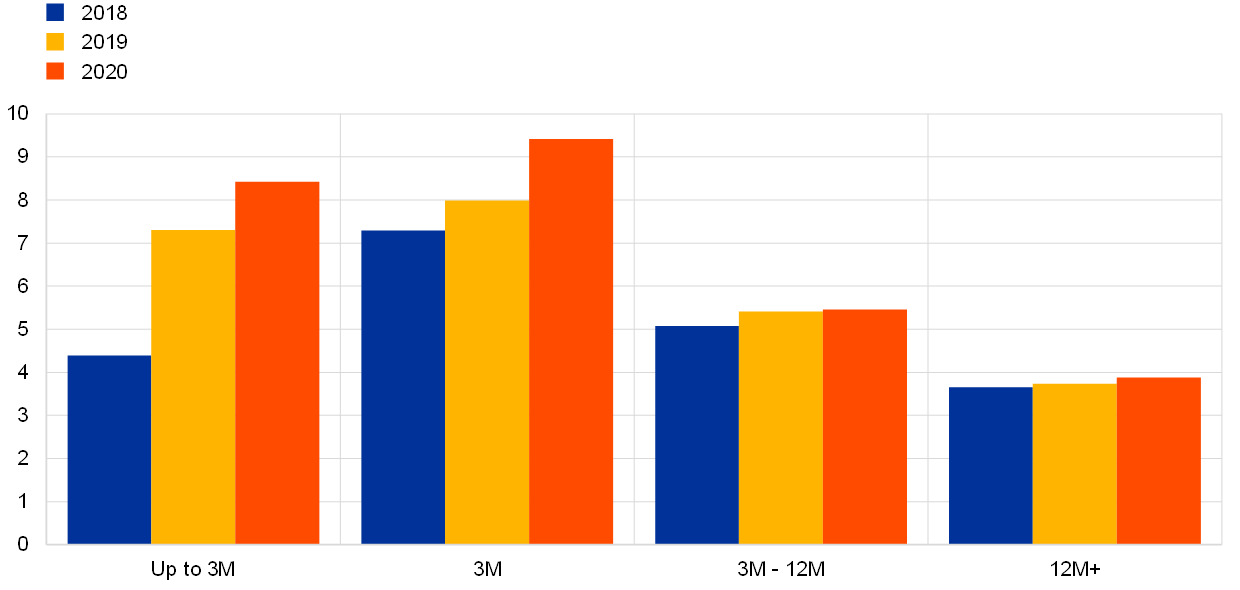
Sources: ECB (MMSR) and ECB calculations.
Notes: Average daily volume of paid and received transactions. Spot trades only. Excluding novations.
Outstanding amount per maturity
Outstanding amount is dominated by contracts above one year (see Chart 5.9). Unlike other money market segments, derivative contracts can have very long maturities, up to as long as 50 years. While transactions with longer maturities are less frequent, they represent a larger weight of the stock of derivatives, especially if they have a high notional underlying value. Accordingly, 62% of the stock of OIS trades is made up of trades with an original maturity of more than one year, while 22% of the outstanding amount is in forward contracts. The maturity breakdown of the stock of OIS trades outstanding changes very slowly.
Chart 5.9
Share of total outstanding amount by original maturity
(percentages)

Sources: ECB (MMSR) and ECB calculations.
Notes: The outstanding amount is a snapshot taken at 15 September 2020, in order to avoid reporting dates. The outstanding amount transforms the daily transaction volumes (flows) into a stock variable based on maturity dates. Novations are excluded.
Box
OIS risk, notional volumes and maturity
Notional values have limited information value without a trade’s maturity – both are used to assess of the overall risk of an OIS trade (see Chart 5.10). OIS notional volumes measure activity in the derivatives market, although in order to evaluate the risk of a derivative trade maturity must also be considered.
For example, the risk of a €100 million OIS trade with a maturity of three months is not equivalent to a €100 million OIS trade with a maturity of three years.
The total risk of a trade increases with both the notional value and the maturity. Market participants often use PV01 – the profit or loss arising from a 1 basis point move in market rates – as their preferred measure of risk.
The following example illustrates a risk calculation using the PV01 approach.
A hedge fund may wish to make a profit of €1 million if interest rates increase by 10 basis points at the five-year maturity.
Dividing the desired profit by the interest rate increase of 10 basis points implies that the PV01 of the trade is €100k (10bps * €100,000 = profit of €1,000,000).
At the five-year maturity the notional volume of the trade would be €200 million, calculated as the PV01 divided by the maturity and multiplied by the price move (€100,000 / 5 years * 10,000 = €200,000,000 notional)[26].
The notional value is therefore often the result of a market trade, not the starting point.
MMSR contains the notional value and the maturity of the trade, which can be used to approximate the overall risk at different maturities. Chart 5.M.3 shows that the highest overall risk is at the longest maturities, even though notional volumes are generally lower at longer maturities. Meanwhile, the high levels of notional trading at the three-month maturity result in relatively small levels of risk as the maturity of the trades is comparatively short.
Chart 5.10
Risk, notional volumes and maturity
(left-hand side: EUR billions; right-hand side: EUR billions per basis point)

Sources: ECB (MMSR) and ECB calculations.
Note: Notional is the sum of transaction volumes over the period 2019‑20 in MMSR. Excludes novations.
5.4 Counterparties
CCP clearing
Around 90% of OIS transactions are centrally cleared (see Chart 5.11), the high share being a permanent feature of the OIS segment. The remaining 10% are traded bilaterally between counterparties. Regulatory reasons and prudent counterparty risk management have been the main drivers of the transition towards centrally cleared trades since the GFC. Most financial corporations are obliged to trade IRS in the main G4 currencies via CCPs. The European Market Infrastructure Regulation[27] introduced a specific obligation for large EU-based financial and non-financial firms to clear OIS trades. This came into force in December 2016, with the transition period for full compliance expiring in June 2019. Residual bilateral transactions are mainly between banks and financial corporations, representing around 9% of total OIS transaction volume. Bilateral trades with NFCs and general governments represent just 1%.
LCH Ltd, which is based in United Kingdom, and EUREX are the main clearing houses in the EUR-denominated OIS market. LCH Ltd is the largest clearer for euro OIS trades, although EUREX’s share has been growing since 2018. Anecdotal evidence suggests that some movement from the United Kingdom-based LCH to the German-based EUREX may be driven by regulatory uncertainty surrounding the future of derivatives clearing following the United Kingdom’s exit from the EU. The European Commission recently approved a proposal[28] allowing UK-based clearing houses to continue servicing EU clients until July 2022. In contrast to the euro repo market, where trading has moved to LCH SA based in France, euro OIS swap clearing has remained in LCH Ltd. The euro swap market represents a smaller proportion of the overall swaps cleared in LCH Ltd than its repo equivalent.
Chart 5.11
Average daily OIS volume traded by counterparty
(EUR billions)

Sources: ECB (MMSR) and ECB calculations.
Notes: Average daily volume of paid and received transactions. Excluding novations.
Centrally cleared trading may increase over time, even without further mandatory clearing obligations. Centrally cleared trading simplifies the process of bilateral counterparty risk management, as large exposures are migrated to a single CCP. This also leads to faster pricing, simpler hedging of trades and efficiencies in terms of margin payments, which can be netted across all trades in a clearing house. Furthermore, there are economies of scale for collateral and counterparty risk management. As the market share of clearing houses grows, the relative costs of bilateral trading increase. This is because market-makers can often price and evaluate the risk of centrally cleared trades (which all have the same counterparty – the clearing house) more quickly and competitively than bilateral trades.
Barriers to clearing have recently been lowered for non-banks, as clearers adopt different models of membership. Innovations, such as EUREX’s ISA Direct Model or LCH’s Sponsored Clearing, make buy-side participation in clearing easier than it was in the past. For these reasons, firms that are not subject to a clearing requirement, such as debt management offices, pension funds, supranational agencies and central banks are increasingly joining clearing houses, even though they are largely exempt from clearing obligations.
Flows per sector
Banks tend to use OIS for hedging while hedge funds use them for speculating. Participation in the OIS market is largely dominated by commercial and investment banks (some of which act as market-makers), hedge funds, pension funds and issuers of securities. Motivations for entering into transactions in the OIS market include hedging and portfolio rebalancing, as well as taking positions with regard to the future path of central bank rates. The evidence suggests that commercial banks often trade in the market on their own account or on behalf of customers who are hedging risks. Pension fund activity is usually driven by the need to adjust portfolio exposures, particularly at longer maturities. Hedge funds are most likely to take speculative positions in OIS markets, anticipating changes in central bank policy rates or moves in overnight interest rates.
Flows per jurisdiction
German, French and Benelux banks are the main players in the OIS market (see Chart 5.12). Trades are thus concentrated, with the ten most active banks representing 85% of market turnover. French banks account for more than half of all OIS transaction volumes, followed by German banks with approximately a quarter. The largest share of non-CCP trading is with other counterparties in the euro area, followed by counterparties in the rest of the world and in the United Kingdom.
Chart 5.12
OIS transaction volume flows across jurisdictions
(nodes: total volumes per jurisdiction; connections on top: left agent receives fixed flows from right agent; connections on the bottom: left agent pays fixed flows to the right agent)

Source: ECB (MMSR), ECB calculations.
Notes: The blue lines represent flows within the euro area, the green lines represent international connections, the grey lines indicate trades with CCPs.
Appendix
Money market statistical reporting (MMSR)
MMSR gathers daily information on activity in the euro money markets. The aim of the transaction-based statistical data of MMSR is to provide the Eurosystem with a comprehensive view of activities in the euro money markets. This is to assess the effectiveness of monetary policy and to assist the Eurosystem in maintaining stability in the financial markets.
MMSR data collect all individual transactions in euro with maturities of less than one year conducted by the largest 48 banks in the euro area. The transactions have maturities lower than 397 days.[29] Data should be reported to the ECB every day by 07:00 – reporting started on 1 July 2016. Originally 53, the number of reporting agents currently stands at 48 due to mergers and other corporate actions. The participating reporting agents cover the largest euro area banks in terms of balance sheet size[30] and are listed in Figure C.[31] In operational terms, MMSR data are collected by the ECB with the support of several NCBs. The legal framework for MMSR is laid down in Regulation (EU) No 1333/2014[32].
MMSR data cover four segments of the euro money market: secured, unsecured, FX swaps and OIS. Both legs of the transactions are reported. This means that both lending and borrowing transactions are covered in the secured and unsecured segments, both the selling and the buying of foreign currency are covered in the FX swaps segment and, finally, both the paying and the receiving of fixed interest rates are included in the OIS segment. Transactions are reported for trades conducted with non-retail counterparties such as other credit institutions, other financial corporations, NFCs and governments.[33] Table A.1 lists the main characteristics of the transactions reported for each segment.
Information is reported on the volume, pricing, maturity and counterparty for each transaction. For each transaction, reporting agents are required to provide a set of attributes. The most relevant attributes include the trade date, the maturity structure (settlement date, maturity date), the turnover (the amount involved in the transaction), the counterparty (even if it is a tri-party agent) and the pricing (the interest rate for the secured and the unsecured segments, the fixed interest rate underlying the contract for the OIS, and the spot exchange rate and forward points for the FX swaps). The counterparty to the transaction must also be reported, preferably by providing its unique legal entity identifier (LEI)[34]. For secured transactions, the security employed as collateral, identified by its international securities identification number (ISIN), is also provided. Table A.2 provides a summary of the main information available in the MMSR data.
Identification of the counterparties has recently improved. The MMSR dataset has evolved over time, through amendments to the MMSR Regulation seeking to improve the data collection. Two relevant changes took place in March 2019. First, the reporting of the LEI was extended to all counterparties when it was available. This change increased the number of transactions for which the sectoral classification is centralised in the ECB, ensuring consistency and providing a more accurate picture of money market transactions. Second, the scope of the eligible counterparties was extended to financial auxiliaries, as well as captive financial institutions and money lenders, in the process improving the completeness of the MMSR data collection.
MMSR reflects new trades, while lifecycle events affecting existing transactions are not covered. MMSR collects information on transactions in respect of their generation or “re-generation” through renegotiation or novation. Lifecycle events such as early cancellation or margin variation are not reported, while open-ended transactions are generally reported daily. MMSR data cover wholesale money market transactions performed by the euro area reporting agents (including their branches in the European Free Trade Association and the United Kingdom) with any counterparty in the world. Trades taking place between reporting agents are reported by both parties.
Figure C
Reporting agents contributing to MMSR

Source: ECB.
Note: A more detailed list of reporting agents is available on the ECB’s website.
Table A.1
Scope of reporting for the four market segments included in MMSR

Table A.2
The main information available in MMSR
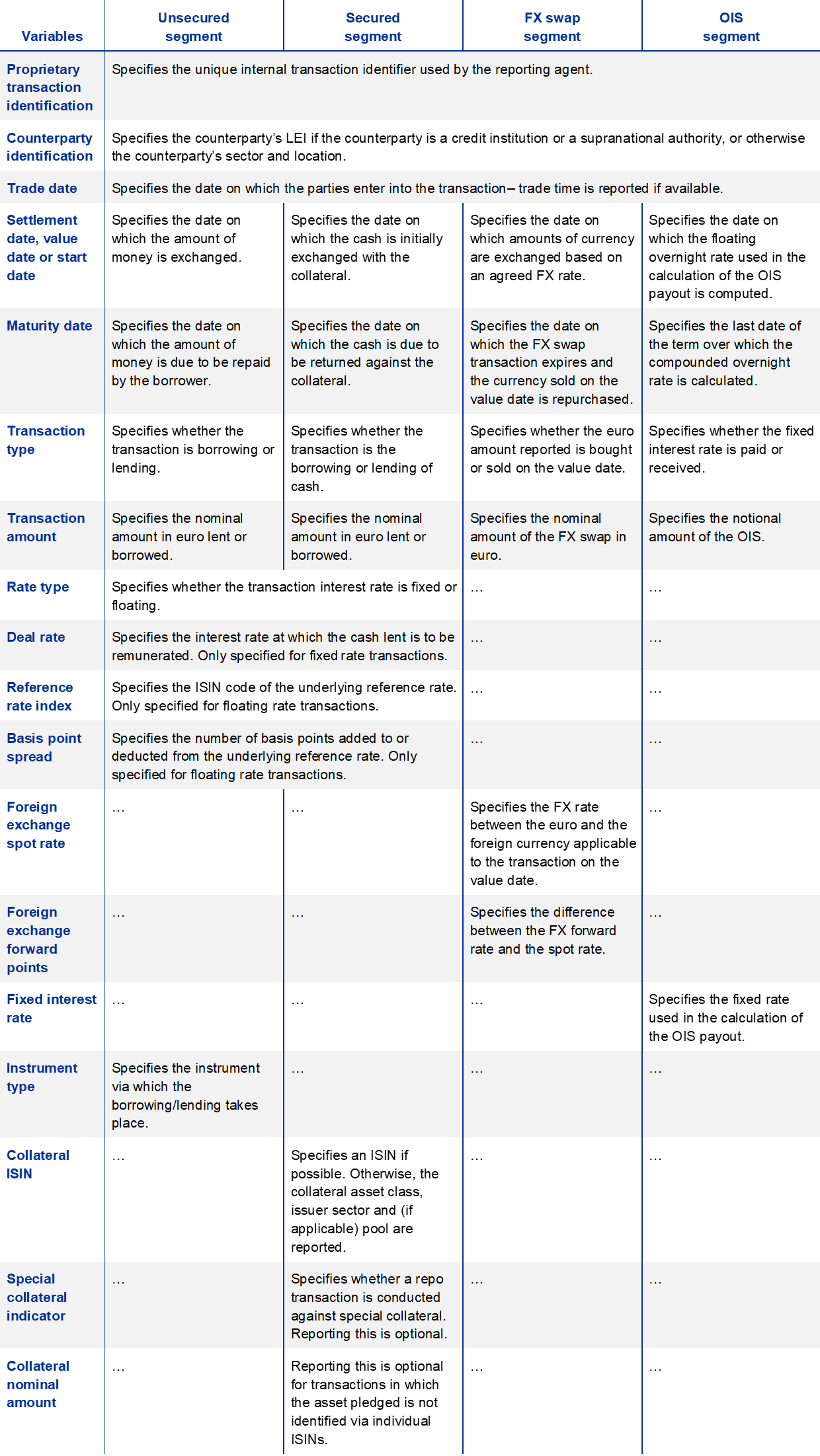
Source: ECB.
Note: The above table is a selective and abbreviated overview of the variables reported to the ECB in the context of MMSR. For a comprehensive overview, please refer to the MMSR reporting instructions, available on the ECB’s website.
© European Central Bank, 2021
Postal address 60640 Frankfurt am Main, Germany
Telephone +49 69 1344 0
Website www.ecb.europa.eu
All rights reserved. Reproduction for educational and non-commercial purposes is permitted provided that the source is acknowledged.
The tables and graphs included in this study abide by the statistical confidentiality rules laid down in European legislation.
For specific terminology please refer to the ECB glossary (available in English only).
PDF ISBN 978-92-899-4736-7, ISSN 1830-3781, doi: 10.2866/577326, QB-XX-21-001-EN-N
HTML ISBN 978-92-899-4737-4, ISSN 1830-3781, doi: 10.2866/647328, QB-XX-21-001-EN-Q
- The difference between flows and stock is explained by the average maturity of the transactions. Whilst most trading takes place with very short tenors (O/N, S/N, T/N), outstanding stocks reflect the cumulated weight of open transactions in longer tenors.
- As the market for secured transactions is dominated by trading with CCPs, some transactions between reporting agents are double-counted.
- Borrowing transactions represent cash borrowing against securities (repos) while lending transactions represent cash lending against securities (reverse repos).
- Sometimes there was a counterintuitive positive relationship between excess liquidity and repo rates. For instance, from July 2016 to December 2018 SC repo rates – which stood well below the DFR – gradually rose closer to the DFR, paralleling the increase in excess liquidity. This may be because the Eurosystem’s securities programme alleviated the collateral shortage in the market.
- Majority of secured transactions with NFCs are lending from euro are banks, which are priced at a premium over DFR. The borrowing transactions are priced below DFR.
- One-day maturity trades include overnight, tomorrow/next and spot/next trades. Overnight trades settle on the same day as the trade date. Tomorrow/next trades settle one day after the trade date (T+1) while spot/next trades settle two days after the trade date (T+2).
- The relocation of repo trading by LCH was for business and regulatory reasons. Prior to the move, euro repo clearing was provided by LCH Ltd and LCH SA.
- Unsecured borrowing requires deposits to be backed by high-quality liquid assets.
- Lending transactions in the unsecured segment are only reported in MMSR data when the counterparty is a credit institution.
- Unsecured lending incurs higher capital charges due to counterparty credit risk.
- See Euro short-term rate (€STR) webpage for more details.
- See Working group on euro risk-free rates webpage for more details.
- EURIBOR is the rate at which wholesale funds in euro can be obtained by credit institutions in EU and EFTA countries in the unsecured money market. It is authorised under the EU Benchmark Regulation.
- The analysis in this chapter is based on Short-Term European Paper (STEP) label, Negotiable European Commercial Paper (NEU CP) label, the CSDB data and, more marginally, Dealogic. MMSR data embed two limitations which impede their use in gaining a comprehensive view of the STS segment: (1) While MMSR data only cover issuances by a sample of MFIs that are reporting agents, STEP and NEU CP data include STS from all MFIs, as well as issuances from other entities (corporates and public entities); (2) Unlike NEU CP data, MMSR data do not consider potential early repayment on commercial paper.
- The AuM of MMFs located in the euro area are computed using the BSI statistics which collect data on the balance sheets of all MFIs resident in the euro area. The framework for the collection of BSI statistics is laid down in the ECB Regulation concerning the balance sheet of the MFI sector (ECB/2013/33).
- MMSR data only includes FX transactions in which euro are bought or sold.
- Compared with the volume observed a week prior. Calculated for the period 2017‑20.
- For more information on the swap line network, see What are currency swap lines? and The provision of euro liquidity through the ECB’s swap and repo operations.
- Through swap lines between central banks the ECB can enter into a swap agreement with another central bank and receive foreign currency liquidity until maturity. In turn, the ECB lends the received foreign currency liquidity to domestic banks against eligible collateral.
- Prices of Eurosystem US dollar operations are set at the respective OIS + 25 basis points.
- The reduction to a weekly operation frequency took effect in September 2020.
- In March 2019 the WG on RFR released a series of recommendations to support smooth transfer from EONIA to €STR.
- A novation in money market transactions is typically a substitution of the original contract with a new one, in which one of the initial counterparties is replaced with regard to rights and obligations by a third counterparty. Including novations may lead to double-counting.
- These included a 10 basis points cut in the DFR, the introduction of tiered remuneration for reserve account balances, a cut in the pricing of TLTROs and the restarting of net asset purchases.
- In the future, OIS trades at longer tenors may become more frequent if market participants move away from LIBOR-based derivatives to OIS.
- This simple formula assumes that the maturity of the trade is the duration of the trade, although the two are not always the same. The 10,000 scales the price move into basis points, as 100% / 10,000 = 1 basis point.
- For more details, please see Clearing obligation and risk mitigation techniques under EMIR.
- For more details please see Financial stability: reduce exposure to UK CCPs.
- In line with the ESMA definition of short-term financial instruments. For the OIS segment only, all swaps contracts tied to the unsecured overnight rate are considered to be short term, irrespective of their maturity.
- The selection was carried out based on the total balance sheet assets at the start of the data collection.
- The updated list of reporting agents is also available on the ECB’s website.
- Regulation (EU) No 1333/2014 of 26 November 2014 concerning statistics on the money markets (ECB/2014/48) (OJ L 359, 16.12.2014, p. 97), as amended by Regulation (EU) 2015/1599 (ECB/2015/30) (OJ L 248, 24.9.2015, p. 45), Regulation (EU) 2019/113 (ECB/2018/33) (OJ L 23, 25.1.2019, p. 19), Regulation (EU) 2019/1677 (ECB/2019/29) (OJ L 257, 8.10.2019, p. 18), and Regulation (EU) 2020/2004 (ECB/2020/58) (OJ L 412, 8.12.2020, p. 31).
- Transactions are reported when conducted with financial corporations (except central banks where the transaction is not for investment purposes), general government or NFCs classified as “wholesale” under the Basel III LCR framework. Lending transactions in the unsecured segment are only reported when the counterparty is a credit institution.
- The LEI is a 20‑digit, alpha-numeric code that connects to key reference information and allows clear and unique identification of companies participating in global financial markets. If the LEI is not available, the sector and country of residence of the counterparty is reported.


